THE HOUSE OF FLOWERS
When My World Was Young 1945-56 The Yellow Brick Road 1956-60 What a Wonderful Town 1960-61
Wonderful Town (pt. II) 1962-66 The Gay Sixties 1966-70
The Juicy Life 1971-76
Juicy Life (pt. II) 1976-80
Losing Alexandria 1981-87
The AIDS Spectacle
Losing Alexandria (pt. II) 1987-1990's
continuation: What a Wonderful Town!? - Part II (1962-66)
THE HOUSE OF FLOWERS
Larry found out about a place some gay men knew as the "House of Flowers," which had single rooms for as little as $7.00 and $8.50/week. It was located at 327 West 56th Street (between 8th and 9th Aves.) In leaving the downtown neighborhood that had once been the Old Tenderloin, we were following the historical track of "Satan's Circus" ourselves, whose center had moved to the west midtown area by the early 20th century, which then became the New Tenderloin.
In the fall of
1961 it was a badly
deteriorated section whose tenements were home to a variety of ethnic groups, though by this
time Hispanics may have already been the largest. It was also home to
factories, warehouses and the docks. The unions and the racketeering associated
with the dock area were largely in the hands of the Irish, and one of their
gangs, the Westies, was infamous for the sadism of its "enforcement" methods
and executions. The House of Flowers stood on the northern edge of this neighborhood,
now notorious as
Hell's Kitchen. (Later Hell's Kitchen was
renamed Clinton – no, not after Bill, but Dewitt, I think - sometime in the closing decades of
the 20th century in an effort to disassociate the gentrifying area from its
violent past. Another move in the plastification of Manhattan for the
benefit of ex-suburbanites colonizers.) 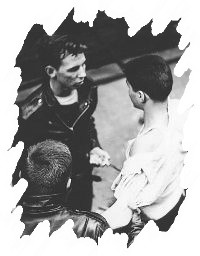
Early 60's gang kids, photo by Edward Melcarth.
Teenage gangs roamed the streets – the infamous "Capeman" teenage gang slaughter took place here in 1959 – and prostitution and drug peddling were invading the streets at night. Fortunately, for someone more influenced by cowardice than virtue, the House of Flowers was located close enough to the decayed respectability of West 57th Street and the Columbus Circle/Broadway business area so that it was much safer than most of Hell's Kitchen.
The first third of the powerful 1996 film Sleepers, starring Jason Patric and Matt Damon, is set in Hell's Kitchen in the Sixties, and though the period setting looks familiar, the antiseptic cleanliness of the streets and buildings certainly doesn't, but even the on-location street settings of the film West Side Story were unrealistically cleaned up..
Hell's Kitchen also had a long history as the home of "fallen women" and bad girls.
Lola Montez
Lola Montez, was an Irish beauty who passed herself off as a Spanish dancer and received the favors of Franz Liszt and Alexandre Dumas, and became the mistress of King Ludwig I of Bavaria. After bringing about his downfall, she fled to America and led a colorful life here, reportedly ending her days in Hell's Kitchen in 1861.
Betty Davis film posterSome of the hard-talking "guys and dolls" from Damon Runyon's famous stories were from this part of the West Side. And Bette Davis celebrated the tradition by starring in the 1935 film The Girl from 10th Avenue, as a tough neighborhood girl who bags a socialite boozer. It was the fourth film version of the 1914 play Outcast, a tribute to the allure of this lurid patch of midtown.
The "House of Flowers" actually had no name. It appeared that it might have been a little hotel for commercial travelers at one time, as there was a tiny room with a Dutch door just inside the entrance with a counter across the lower half of it. In the back of the building there was a line of small one-bedroom apartments with miniscule kitchen space and the luxury of a private toilet. All the rest of the building was divided into veeeeeery small single rooms with one shared bathroom/toilet on each side of every floor. There was no lounge or public space in the place, just rows of doors on every floor. In '61 it was a shabby place, falling apart at the seams, but kept surprisingly clean for a dump.
"Falling
apart" is a totally accurate description, and not a
hyperbole.
One day when I was showering I heard a peculiar noise somewhere above and behind
me. I took a step forward in order to turn around and look up, and
something scrapped down my back and crashed into the tub. A brick had
fallen out of the wall near the ceiling.
(right) The 1955 cast recording
The denizens were almost evenly divided between penurious old straight men and young gay guys who were marginally employed or down on their luck. The gay guys were completely open about their sexuality, but the two groups seemed to co-exist with few problems. Sometimes when I came home there would be a mixed group of old men and young gay guys drinking beer together on the stoop.
My room, like the rest, was furnished with an old iron cot and a rackety chest of drawers, a sink and herds of roaches that swarmed across the walls in Rorschach-like formations. Larry had a similar room two flights up, on the floor where the pay phone was located.
The place was run (but not owned) by Helen, an elderly Irish-American woman, who was raising three young granddaughters there. She was a decent person, and willing to hold off on collecting the rent for a few weeks for guys she trusted, and she and her granddaughters, who were just entering their teenage years, took the gay atmosphere in stride.
The House of Flowers nickname referred to a popular
mid-50's musical based on a short story by Truman Capote. It had starred Pearl
Bailey, Diahann Carroll and a mostly black cast. "Two Ladies in the Shade of a
Banana Tree" and "Sleeping Bee" were popular songs from it. The story concerns
the lives
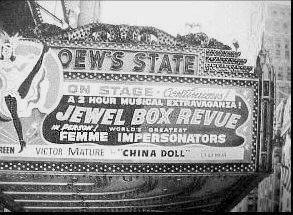 and loves of the women in a Caribbean brothel during a Mardi Gras
holiday. If the musical romanticized life in a whorehouse, the nickname did the
same for the house on West 56th, and I suspect that very few left it for
significantly better lives. The old straight men left for the hospital or the
gutter, where they died, or like the man across the hall from me, died in their
rooms and were discovered by the smell.
and loves of the women in a Caribbean brothel during a Mardi Gras
holiday. If the musical romanticized life in a whorehouse, the nickname did the
same for the house on West 56th, and I suspect that very few left it for
significantly better lives. The old straight men left for the hospital or the
gutter, where they died, or like the man across the hall from me, died in their
rooms and were discovered by the smell.
(right) 1958 or '59 Jewel Box marquee
The most noticeable gay guys were drop-outs or waiters in cheap eateries, heavy drinkers, many of whom had had dreams of theatre careers, although two did depart for a stint as drag queens in the by then somewhat worn Jewel Box Revue. The far fewer more private guys came and went on their personal rounds, and then at some point you realized that they had left. I lived there from November '61 until early '63.
Someone told me that the place had been used for a scene or two in the film The Hustler, released in 1961 and starring Paul Newman and Jackie Gleason. I have never seen it, so I don't know whether it's true or not.
Larry had introduced me to writers, books and ideas I 'd never been exposed to. He also introduced me to Beverly Aronstein, my first contact with that particularly voracious species, the New York bohemian culture vulture – well-intentioned in her enthusiastic sharing of every piece of crap produced in a basement or a loft, but she and it could be overwhelming oftentimes. In return I took Larry to a small orgy at Tony Montez’s place, just to show that I didn’t hold any grudges.
After we had been living in the House of Flowers awhile Larry got a chance to go to Europe gratis, bid me adieu and managed on the strength of his wits and charm to stretch it out for two years. It was after he left that I saw Fellini's 1960 film, La Dolce Vita, a movie Larry had urged me to see. Because he had a one-way ticket to Rome, I projected the film onto his adventure, but in its circus-like and picaresque aspects, at least, it was a reflection of my life in New York too.
Larry's companionship, aside from being a pleasure, had filled a large social void in my life. With such a tiny amount of cash to live on I was in no position to join people for a night out at a bar, and even when there were get-togethers in Arthur’s apartment or someone else’s I had felt uncomfortable showing up with a single can of beer. And though friends were nice about treating me or inviting me to dinner, there was no way that I could continue to have the normal social life I’d just started at the end of my stint at the Times.
LOVE FOR SALE
My room was $7.00 or $7.50 per week, which left $19.50 a week for food, laundry, transportation to employment agencies or interviews (when it was too far to walk) and stuff like soap, razor blades, toothpaste, etc. So, one night when I wanted “company” and couldn’t spare even enough to buy one beer at a bar, I walked down to 42nd Street. While it was hustler central, it was not all sex-for-cash, I knew.
 I was uneasy with the
scene, but I did it a couple of times and picked up someone. However, several
older guys had approached me looking to buy and I fobbed them off. Not that I
had moral objections to selling, rather it was a matter of zero confidence in
being able to put out for people I might not be attracted to, as well as fear of
getting a weirdo or cop.
I was uneasy with the
scene, but I did it a couple of times and picked up someone. However, several
older guys had approached me looking to buy and I fobbed them off. Not that I
had moral objections to selling, rather it was a matter of zero confidence in
being able to put out for people I might not be attracted to, as well as fear of
getting a weirdo or cop.
Times Square 60's love for sale (detail from photo by Lehnartz)
However.......even five dollars a week more would mean that I could finance a night out with friends…or have a little more for food…or deal with unexpected things like getting a rumpled suit pressed. And I did have a single room with a bed....near Times Square...and in a place where nobody asked questions.
My hustling venture was brief and - fortunately - undramatic. One married guy from the suburbs I took back to the House of Flowers kept gassing on and on about how he wanted to come back to have me model for some sketches. Maybe he'd seen La Boheme one too many times, or maybe this fantasy was just his way of romanticizing an otherwise unsavory indiscretion. Another guy "happened to have" a camera with him and snapped a few shots of me, and although none of them were completely naked I wouldn't be surprised to see them turn up on a vintage gay photos site some day. All in all, it was truly pretty tame stuff. Having zero idea of what flesh on the hoof was worth, it was a matter of very small bills. However, it accomplished what I had hoped: I had a few bucks in my pocket to go out with friends on a weekend without talking poor-mouth, and if I was careful I didn’t have to decide on whether to eat, but just what. I got a job fairly soon, which should have meant a quick exit from the flesh trade. However, at this time the fee charged by the employment agency was normally paid by the successful applicant, and you signed a contract with the agency which set the payment terms and installments. Thus, a pretty decent chunk of your first few checks was owned to them. The solution was obvious -- until the fee was paid off I continued to seek out "the kindness of strangers."
Not every contact was for money, some guys who were hanging out there were also
ready sometimes for plain old "recreational" sex.
There was a very short bodybuilder who used to hustle
the street, but around dawn he'd invite you back to his place, and you could
screw him silly while he looked at the female pinups pasted on the walls around his
bed.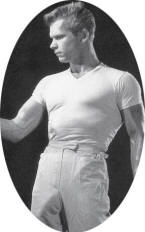
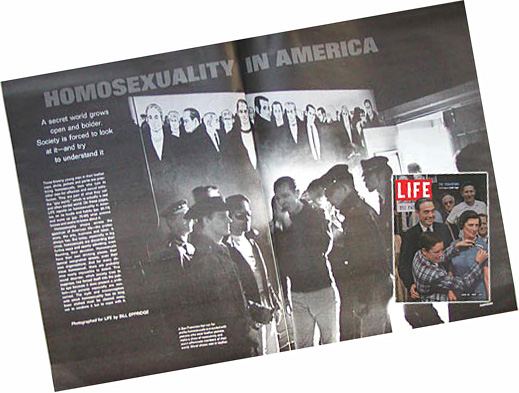 The Fifties have been called the Golden Age of Trade,
and the early Sixties were still part of that era.
The Fifties have been called the Golden Age of Trade,
and the early Sixties were still part of that era.
(right) Don Hawksley
A member of a Yahoo vintage physique photos group described the scene thusly: "The denizens of the old time hustler bars in the area might compare to the magnificent studs who posed for Bob Mizer of AMG [Physique Pictorial], Bruce, Milo et al. in the 50s & 60s. In later years there would be pathetic drug addicts and ex-cons working as rough trade, and brutal gangs of kids from Hell's Kitchen on the street. But in the late Fifties and early Sixties it was a world where you could imagine running into a Jack Deal outside the USO or a Monte Hanson in the Haymarket or a Don Hawksley getting off a bus at Port Authority or a Fred Frandac playing pinball in the arcade next to Nathan's."
Now it's that mouse and a duck!
Lo, how the mighty have fallen,.... Or something like that. What a world it was.
Life magazine may have given gay life an unintended shot in the arm with a 14-page article in June 26, 1964. While definitely negative in tone, its sheer length in a family-oriented, major American publication was testimony to the pervasiveness of the gay subculture in the U.S. And, despite the tone of disapproval, many a gay man in the provinces must have taken heart, realizing that not only was he not alone, if he could haul ass to some bigger burg he would find a feisty and relentlessly self-renewing gay counter-culture. That most straight readers were probably appalled by what they read, I do not doubt...and surely more than a few would have thought that Life had lost its mind publishing such an article.
LOOKING FOR
“AN HONEST JOB”
Once I got down to it the job search didn’t really take that long – eight weeks or so. And after I had the agency fee paid off all I ever saw of 42nd St. was from the window of a bus. However, the job hunting was an unpleasant eye-opener in a couple of respects.
First, while I realized that one year as a copy boy and clerk at the Times cut no ice, I was not prepared for the fact that a major in Journalism would get the same reception as a fart during sex. I was looking for an entry-level position with a periodical or in publishing, but no one failed to comment that a major in Journalism had been a waste of my time and majoring in English is what I should have done. A couple of interviewers dismissed the very idea of a major in Journalism as an academic bogosity—a view I had already run into at the Times.
At least two of my classmates in the S.U. School of Journalism might have bridled at these assertions: Ted Koppel and Joyce Carol Oates. Oates and I came from the same area of New York State, and some of her fiction is set in that part of the country. I enjoyed her earlier books With Shuddering Fall, A Garden of Earthly Delights, and Them very much and also a later one, What I Lived For. A 1996 Times review said of her: "Joyce Carol Oates's novels and stories seem to appear with the regularity of long-distance buses, often bound for depressed areas of western New York State . . . much of Oates Country can't quite be found on the map; but its all-American mix of biblical and Indian place names, its terrain and vegetation and its rooted but lost inhabitants make it equally persuasive." And for me they are return trips to the days when I was growing up in these rural counties.]
These objections to the Journalism major were easily dealt with by turning my academic background inside out. I rewrote my resume so that my other major, Anthropology became my major – renamed Sociology, though, to sound less like I had spent four years in a pith helmet interviewing chatty cannibal informants – and demoting Journalism to a minor. And I faced the fact I had better follow up any reasonable openings, and drop the publishing pipe dream – unless I wanted to be one of the House of Flowers losers. Later I learned that many companies did not check your academic credentials, and I probably could have quite safely put down most anything I was prepared to bluff my way through – leaving aside the obvious mismatches, e.g. – football, theology, brain surgery, etc. But I didn’t know that, and lacked the chutzpah to pull it off in any case.
However, I was still not quite off and running.
The other problem was not as easily dealt with: my draft status. My previous 1Y classification had indicated prime draft bait. My new 4F status signaled a serious physical or mental disability or homosexuality. If I lied and claimed that I had served in the army, I could find myself in the position of being asked questions about my military service that I might easily stumble over, or worse be asked to produce my official discharge papers from the armed forces. So, I stuck with the truth and put down 4F.
That classification almost never failed to stop traffic. There were those perfunctory interviews where it was simply noted out loud in passing. But interviewers who saw me as a possible candidate, presumably, were more probative about the health problem that had resulted in this status. Some would then pursue a follow-up line of questioning focused on dating, girlfriends, plans for marriage, etc. Trying to balance the drama of my sufferings from a “trick knee” against titillating tales of a heterosexuality that bordered on priapism would have challenged an Actors Studio graduate.
The upshot of these performances was that I received as many job offers as Emmy nominations.

Again, I went simply to chalk up brownie points for the Unemployment folks. This time there were only three of us, as I recall, and the same guy gave us an informal down and dirty on what we’d be doing. Essentially they looked for any personal problems or habits in the people they investigated that might reflect badly on their employers or incline the employee to embezzle from the firm, etc. They questioned neighbors, stores, former co-workers, and so on, looking for evidence of gambling, too great a fondness for wine, women and song, adultery and—of course—(surprise, surprise) homosexuality. He regaled us with anecdotes about their work — a depressing narration of human frailty, conclusions often drawn from third-hand gossip and circumstantial evidence, and the joy of another life ruined. The other lucky applicants I checked off as straight, but from the interviewer’s smiles and eye contact with me when he would launch into a tale of hidden homodom, I got the message: he saw the logic of “set a thief to catch a thief.” No thank you.
What I desperately needed was to find any reasonably
responsible job and put in a couple of years at it. This would give me a
better employment base on my resume than “copy boy”, but more important, I hoped
that enough creditable work experience and time would make my draft status
irrelevant. It was an eminently sensible conclusion, and it propelled me
to make a decision located somewhere between folly and masochism.

The God of Math
I had been an A student in grade school arithmetic, but when long division was sprung on us in the fifth grade I had been completely undone. I could barely scrape through arithmetic after that, and when arithmetic became math it was worse. If gym classes were my Scylla, math was my Charybdis. Thus, when very soon after the snoops-for-hire episode I was offered a job, the fact that it was as a “media analyst” crunching numbers on an electric calculator all day did take the shine off it more than a little.
Nevertheless, in January of '62 I began a two-year stint working for Kelly-Smith a firm which represented newspaper clients from around the country and sold their display advertising space to Madison Ave. ad agencies. Though my income increased, I continued to live in my room at the House of Flowers for more than a year afterwards.
MEANWHILE, MORE OF THE SAME
 The meat racks along various dark streets such as
Greenwich Avenue and Christopher Street in the Village, the west side of
Washington Square and Central
Park West (uptown) were regularly patrolled by
police cars. The one
along Washington Square was virtually driven out of existence, and the long blocks of
cruising along Third Avenue followed suit over the next few years.
The meat racks along various dark streets such as
Greenwich Avenue and Christopher Street in the Village, the west side of
Washington Square and Central
Park West (uptown) were regularly patrolled by
police cars. The one
along Washington Square was virtually driven out of existence, and the long blocks of
cruising along Third Avenue followed suit over the next few years.
(right) The lower part of the Rambles area in Central Park
Central Park West was regularly cruised by police cars and the famous Rambles within the Park were subject to raids. (The latter was a place where people actually had sex and not a place just for picking up as were the meat racks.) Nevertheless, an appointment book that I used from late April 1962 until the end of that year to keep track of my erotic peregrinations indicates that in the Village I picked up one guy on Seventh Ave., five on Christopher Street and five on Greenwich Ave., while on Third Ave. I met yet another five and on Central Park West, four.
The Everard Baths stayed open during these years, for the entire time as far as I know, but then it was rumored among gay men that the reason they were never bothered was that they were operated for the benefit of the Police Athletic League (a charity run by police officers.) This was probably a myth, but it was believed by many, many guys, and it does seem quite remarkable that the Everard survived during this repressive era. If you have read Dancer From the Dance, Andrew Holleran's novel of NYC in the 70s, these are the baths he describes. Though I don't remember my first visit there it was probably sometime in my first two years in the city. The Everard was funky, not like music can be funky, but more like an old pair of gym shoes is funky. Some other baths closed – like the PENN-POST – though in this era the baths, like leather and S&M were regarded ambivalently by quite a few gay men.
The 19th Street Cafe disappeared quickly, though the Coronet lasted until June at least. The most popular bar was an unlikely place on the east side of Third Avenue just above 57th. Jack and Nats was excruciatingly bright with overhead fluorescent lighting and until about early May had been just another one of dozens and dozens of leftover working class bars in a rapidly changing neighborhood. But in early May it turned into a gay bar that lasted for most of the year. Early in June an old Village landmark with 1940's murals by Franz Kline, the Bleecker Street Tavern – serving steins of draft beer – turned gay; however, it lasted only a short while before closing as a gay place. I discovered in June that the New Colony on Greenwich Ave. was open. I'd never been there – it had gotten a big thumbs down during the summer I'd lived in the Village as a place nobody went to – a "wrinkle room." While the De Lys and the Cherry Lane closed not long after I had arrived in the city, the New Colony, perhaps because of its relative unpopularity, must have lasted comparatively longer (unbeknownst to me), or else had closed to protect its license and then reopened later for a brief stint – which is more likely, I think. In any case, it was quite popular until it closed a some months later. I used to meet up with Tony Montez there, and like him a noticeable number of guys were in jeans and leather jackets. Playwright, Edward Albee was one of the customers. Of course, Julius's was open – the bar with gay customers that didn't want to be a gay bar – but as always during these years it was a place of unpredictable hospitality and anti-gay policies. Late in the year two other bars, the Fo'c's'le and Dirty Dick's opened but died a quick death (one or both may have been in the place that later became Badlands at the end of Christopher St.) The same tattletale appointment book says that I met twenty-three guys in these places.
And to round out the picture: I went to Fire Island for the first time in August of 1962 and met two guys there, another at Riis Park and four more at parties.
The bottom line is forty-nine guys, however, these were not by any means all
one-night stands, so the number of times I had sex that year is a rather larger
number.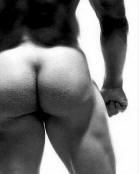
I would come back from my Saturday night revels and drop into bed just before dawn every Sunday a.m. A few hours later there would be an insistent rapping on the door! And each Sunday I would get up -- hoping to find that Dialing for Dollars was calling for me on the single pay phone in the hall two flights up – only to be confronted by two Jehovah Witnesses. Sunday after Sunday the same man and woman; Sunday after Sunday I was nice and polite and said, "No thanks."
Then came the Sunday they awoke me from a hangover so painful that it could have been an abortive suicide attempt. I ripped off my shorts, flung open the door, leaned butt naked in the doorway and said, "YES, LET'S TALK ABOUT JESUS!"
They never came back.
I still have great memories of one of these many fly-by-night bars, the Hat Box near Herald Square (circa 1963). One of the bartenders was a older, pug-faced man who later in the decade worked at the Stonewall Inn. Some of the Hat Box's stand-out customers were a couple of chorus boys from Westside Story in muscle t-shirts, as well as an often drunk and very nasty Paul Lynde, however most of the crowd was not theatre people but a mix of just plain ol' guys.
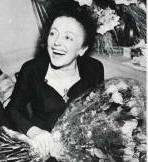
(right) Edith Piaf
And I remember that it was Edith Piaf's rowdy Milord that played over and over — not Judy Garland's Trolley Song — so it seemed to me that part of the world of the old Lenny's Hideaway had been entombed behind its padlocked door.
The unstable bar scene made for a fragmented public gay life, as that life was a repeated search for the newest gay meeting place. Because there were so few opportunities for meeting people in a safe environment, parties were fairly frequent, and impromptu after-bar-closing parties were very popular. Bars closed then at 4 a.m. or 3 a.m. on Sunday mornings. Shortly before last call someone might tap you on the shoulder and ask you if you wanted to go to a party, and oftentimes you knew neither the inviter nor the person giving the party. There was always a rush to find an all-night grocery or delicatessen where you could buy beer, and groups of people piling into cabs and ending up at some stranger's apartment. There was no standard party, of course, and you could wind up in some very unexpected circumstances. But, usually it was a gang of ordinary guys and a chance to meet people and have a good time, and find a trick maybe.
There were no widespread problems with theft or bad behavior that I recall – except for someone getting too drunk – which is surprising when you consider that many of the guests weren't known to the host or even to each other at these spur of the moment parties which began at post-3 a.m.
One evening during this period I was at a large party of gay men (this one was not an early a.m. after-closing party), when three guys came in with two girls. There were no women at the party, so it was this that made me pay attention to their entrance. Then I realized that one of the guys was familiar. He looked across the room and seemed to recognize me. It was Andy, the one brother back in my freshman year at Syracuse who had remained pleasant after I had dropped out of the fraternity. The group left almost immediately perhaps because there were no other women, perhaps....perhaps what, who knows? An odd moment after four or five years.
About this
time a low-keyed, affable guy, named
Harlon Cranston, arrived in New York from the South or Midwest. He had two
equally pleasant and easy-going "boy-from-the-provinces" types for roommates
when I met them. Their quarters were cramped, but they then lucked out and
found an affordable duplex in an old house in the Murray Hill neighborhood,
which gave the three more living space. It also gave them a great place for
parties. The apartment occupied the
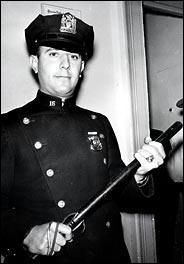 front of the building on the ground
and first floors, which meant having lots of people arriving for a party wasn't
noticeable to everyone in the building, and as the apartment was not over another
one, the noise was far less likely to annoy the neighbors. One of the
problems with giving late night parties of gay men was possible complaints to
the police about the noise.
front of the building on the ground
and first floors, which meant having lots of people arriving for a party wasn't
noticeable to everyone in the building, and as the apartment was not over another
one, the noise was far less likely to annoy the neighbors. One of the
problems with giving late night parties of gay men was possible complaints to
the police about the noise.
While straight people giving similar parties
could also find themselves facing two cops at the door as the result of a phone
call to the police, they had far less to worry about - after all, they were
straight, which meant their only offense was disturbing their neighbors.
But if the cops arrived and discovered a party of gay men, they might decide to
do more than give a lecture. To be honest, usually they just gave
a friendly warning to "keep it down" and left it at that. However, if they
had it in for gay guys then they might insist that everyone leave - or threaten
to notify the landlord about the host's unwanted activities, or threaten to
issue a summons to the host or even the guests as well. If you did get off
with just a warning, a second visit from the cops was serious business, and if
the cops didn't order everyone to leave, it would usually cause most guests
to quickly depart anyway, happy to have avoided a worse confrontation. A party of
gay men was just what the vague offense of "running a disorderly house" was
tailor-made for, and it did not refer to the state of your housekeeping.
(Fortunately under these circumstances, at this time the use of marijuana, much
less other harder drugs, was extremely rare, and no one I knew of in these
years used it or would have allowed it at a gathering in their apartment. Anyone who
had had the balls to light up a joint
would have been thrown out of most parties probably.) 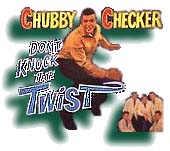
At first Harlon and his roommates would call up a few guys for a Saturday night party, but in a month or two the problem was not inviting guests, but finding room for all the guys they hardly knew, or didn't know, who showed up at the door with a six pack. By midnight or one a.m. the place would be packed like the proverbial can of sardines – downstairs and upstairs, and guys just continued to reach for the beers even after their original bring-your-own was gone – which meant that there were sometimes party-wide collections to replenish the beer supply. There was the usual predominance of slow dance music, and I can remember Johnny Mathis songs for sure, but Chubby Checker's twist music and its spin-offs got played too.
For a brief time in this repressive era, Harlon, with his "Corn Belt"
looks and manner, was sometimes jokingly called "the gay Pearl Mesta," a
reference to the legendary Washington party-giver who was the basis for the
musical Call Me Madam. However, his parties were totally informal,
something on the order of college mixers, I suppose, and by the end of the
evening in the early hours the apartment looked like a shambles.
"CHANGE AT BABYLON!"
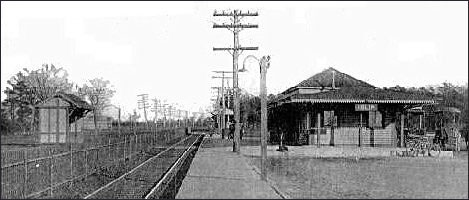
Though this is the long gone Islip station on the LIRR, the one at Sayville looked just like it in the early 60's.
If there was anyplace where freedom existed, it was in the never-ending folly that was Fire Island. I first went there in August of '62. Our arrival was to be an appropriately spectacular introduction.
We took an express train from Penn Station, and then
changed at Babylon for the local which took us to Sayville, where the ferries
left from. My host and I and one or two other guys then squeezed into a
normal size taxi for the ride to the ferry (the large rank of more commodious
vans and taxis waiting at the train station was off in the future.)
Storm clouds were gathering, and at the dock we found that we faced a long
wait for the next scheduled ferry departure. So, along with two or three
other people in the waiting crowd, my hosts decided to take a "special," i.e. - a
very small open boat that could be hired take eight or ten people across.
It was getting darker and darker as the storm barreled our way. By the
time we were a mile or so into Great South Bay the boat was bouncing up and down
on white-capped waves, and with the spray and the wind we were getting pretty
wet sitting on a bench that wrapped around the open back of the boat. The rain started,
and lightening too, visibility was heading toward zero - as far as I was
concerned we could have been in the middle of the North Atlantic, and the other
seasoned passengers looked anything but confident. The pilot and a
companion were housed under a slight roof, and the passengers now crowded in
under it and stood behind him - not a great idea I would think, but I guess he
had all he could do
 to handle the boat. We were all trying to find
something to hold onto in order not to fall down, and our view was out the stern
at a cauldron of black water pitching with waves.
to handle the boat. We were all trying to find
something to hold onto in order not to fall down, and our view was out the stern
at a cauldron of black water pitching with waves.
The splendor of Belvedere, Cherry Grove
Most men were not real happy about going to their regular GP with a case of venereal disease, much less to a public health center. There were, however, several gay doctors who were known (a bit ungratefully under the circumstances) as "clap doctors." The two most well-known ones in the early Sixties were both Dr. Brown - Eugene and Clarence. The former was an attractive young man, occasionally seen at the baths; the latter was a balding, middle-aged man with wire rimmed glasses and a pink cherubic face.
Suddenly the rain stopped, and thoroughly soaked anyway we passengers sat out in the open deck space again. Angry clouds still filled the sky, but a spot of grey light was trying to cut through them, and I could make out the dark line of the Island emerging across the horizon; then, suddenly a shaft of sunlight broke through spotlighting a huge white, Baroque wedding cake of a house rising above the trees -- Belvedere, the prima donna of Cherry Grove houses!
The Island has gone through many changes since then. Again, as in the case of having seen the last of the Bird Circuit bars, I really saw the very last gasp of a Fifties – and maybe, Forties – lifestyle in Cherry Grove.
Fire Island is one of the northernmost of the long string of barrier beaches which stretch from the Carolinas along the eastern seaboard to Long Island. For the most part they are simply enormous sandbars that have piled up to the proportions of narrow but extremely long islands with scrub forests and fields of sea grass with deer and other wild life. They
 protect the low-lying coasts from
storm erosion and provide a protected waterway between themselves and the
mainland
coast.
protect the low-lying coasts from
storm erosion and provide a protected waterway between themselves and the
mainland
coast.
(right) Cherry Grove dock (photo: R. LaFrance)
In actuality the Fire Island barrier starts right in New York City, at Riis Park and the Rockaways - though it is not called Fire Island at this point; it extends northward - where Jones Beach is part of it; and then becomes Fire Island proper along the ocean side of Long Island.
It is less than a mile at its widest point, though it must be around 35 miles long (I think). There were no roads and houses were built on platforms raised up on pilings as were the wooden boardwalks. No private passenger vehicles were allowed, but service vehicles and beach taxis (four-wheel drive jeeps) drove on the beach or within the settlements on "roads" through the sand. Only one of the communities, Ocean Beach, had more than one or two permanent, year-round residents.
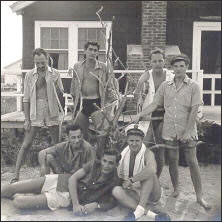
I
n the 1930s gay people in the theatre began going to Ocean Beach (a bit farther west on the Island.) When their presence drew unwelcome attention, I've been told by several old timers, some of them rented in the next settlement up the beach, which was a handful of summer houses then called Cedar Grove.A group of 1950's housemates in a Cherry Grove bungalow
In the early 60s a few people still called a small part Cherry Grove's far west end Cedar Grove, so perhaps it's a fact. However, Cedar Grove and this story don't figure in any of the standard histories of Fire Island and Cherry Grove, so maybe it's not. Whatever the truth, in the post WW II years Cherry Grove had attracted more and more gay vacationers and property owners.
By the time of my first visit in 1962 it had become all but completely gay. Only about four or so houses in the Grove were were pointed out to me as being occupied by straight people then. Cherry Grove was reached by a ferry from Long Island, a twenty minute boat ride and few miles across the water, but a world away. In 1962 some of the houses - like the one I stayed in - still lacked electricity and were lit by kerosene lamps, and the stoves and refrigerators ran on bottled gas. The boardwalks were very dark and trees and bushes often obscured the infrequent "street" lights. Almost everyone carried a flashlight as the public lighting was so poor that falling off the boardwalk was a real, and not always minor, danger. During summer weekends the population would reach several thousand people, and it was a gay community, despite the usual police harassment...and it was publicly and defiantly and outrageously gay. There was one large hotel having perhaps one hundred fifty to two hundred small twin bedded rooms (I'm guessing) each with a shared bathroom, and a much smaller establishment, the Cherry Grove Inn (I think that was its name.) Rooms in both were "furnished" on the level of a summer camp - though the large hotel, owed by Jimmy Merry, had a bar, a large dining room and a recently installed pool between the two wings of the U-shaped structure. Then there were guest rooms for rent at the unbelievable Belvedere, but most of the Grove was private homes which were rented out to groups for the summer or occupied by their gay owners.
 An unexpected sighting was that of a drop-dead handsome, competition-level bodybuilder, whom I
was told was the young Nineteen-Fifties beefcake model, Johnny Kemper.
An unexpected sighting was that of a drop-dead handsome, competition-level bodybuilder, whom I
was told was the young Nineteen-Fifties beefcake model, Johnny Kemper.
(right) Johnny Kemper
He was being photographed at one end of the hotel pool, and attracting plenty of spectators, though he had such a scowling face and staring-into-space attitude, not to mention a bikini-clad bimbo fluttering around him constantly, that he gave off vibes of not being very happy with where he was. This was a bit difficult to reconcile with his earlier posing as a frisky ephebe for Lon of New York and others. Nevertheless, drop-dead gorgeous, he was.
The houses were a very eclectic mix from well-worn pre-WW II bungalows, to conventional East Coast beach houses to the wedding cake fantasy and couple of other adventurous creations....all built of wood on wooden pilings. As you approached on a small ferry or a speed boat the first house you saw was Belvedere -- an enormous Italianate extravaganza of a house, whose interior boasted a marble fountain, multiple marble fixtured bathrooms, and chandeliers, all retrieved from Long Island mansions which were being demolished for tract housing. It also had a large pool surrounded by arches and classical nude statuary (I have no idea how the pilings support/ed all these stone accessories!)
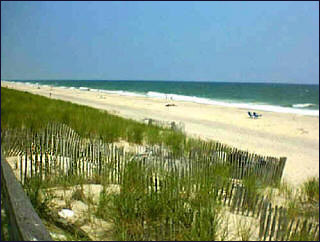 Most of the houses were named: MGM, Les Girls, Les
Boys, Bangkok, Xanadu, Tara, Rififi, Brigadoon, Tir n-an Óg – many of them a
bit tongue in cheek, but memory fails. The parties were what Cherry Grove was
most famous for. (On second thought, it was probably the sex.)
Most of the houses were named: MGM, Les Girls, Les
Boys, Bangkok, Xanadu, Tara, Rififi, Brigadoon, Tir n-an Óg – many of them a
bit tongue in cheek, but memory fails. The parties were what Cherry Grove was
most famous for. (On second thought, it was probably the sex.)
Beach at Cherry Grove (photo: R. LaFrance)
They were extravagant beyond belief, and considering the times – it is amazing that they occurred. Only two words are appropriate to the Cherry Grove parties of this era: Lavish and Outrageous. Those houses that were owner-occupied or rented by the same group year after year were tremendously competitive about these parties and spent a good bit of money trying to out-do each other. There was a community award at the end of the year for the best party and it was highly coveted. The big parties always had a theme.

In the early Sixties Jimmy Merry, a short,
tough-talking New York Mick and former waiter, was the king of Cherry Grove. He
owned the large hotel, which had a bar, and the popular (very small)
restaurant/cruise bar, the Shack. There were two other bars near the Shack, but
neither was as popular as Merry's two places. The bill of fare at the
Shack consisted of simple entrees, such as meat loaf, spaghetti, pork chops and
fresh fish, but it was always very good .
This drawing by George Wolffe shows the shack as it was in '72; however, in the early 60s it consisted of only the two-story section on the left hand side and the rear deck
.
Later, after the restaurant expanded, its menu and wine list became as lavish as that of the best gay places in the city. The bars in the hotel and the Shack, which turned into cruise bars after the dinner hour, were the places to hang out and drink in the early 60's. The Shack was built into the side of an ocean-front dune and had a raised deck in the rear on top of the dune overlooking the ocean. Unless it was pouring rain most guys stood out on the rear deck to socialize and cruise....though it could be freezing ass cold and windy even in the summer.
Although it seemed as if Jimmy rubbed some gay people the wrong way – he did have a rather tough affect, and he had a reputation as being a demanding boss as well as a no-nonsense businessman – he was well-liked by the ferry operators and some other business owners on the mainland. This probably accounts for the fact that he almost always knew when the police were on their way across, and he would quietly put the word out. I can remember more than one occasion when he stopped by our table to do the usual, "How are things?" – and then bent over and quietly told us that the cops would be visiting that night. Another side of Merry was that he was legendarily loyal and generous to hardworking employees. There was dancing at the bar in his hotel, but it was iffy in the early part of the Sixties, sometimes it wasn't happening and other times it was. The solution to avoiding trouble with the police was to have line dancing, such as the Madison, with at least one female in the group. Sometimes two or three guys in drag would make an entrance, and this made many guys uncomfortable. A gay bar was a police magnet to begin with, the dancing made it more likely there might be a problem, but the addition of men in drag really upped the odds. And, no doubt, some men were turned off by drag in any case. At the end of the decade the hotel bar (under a new owner) would claim to be the birthplace of the disco. And Jimmy Merry is credited with inventing that gay institution, "tea."
The population of Cherry Grove was overwhelmingly male, however you would see women having dinner at the Shack, and a few would come into the bar of the hotel. I don't remember seeing lesbians hanging out at the Shack after dinner hour, but across Ocean Walk from the Shack was another place – Peggy's may have been its name, or perhaps it was just the owner's name – and at least in the first couple of years I went to the Grove that seemed to be the place where the women went.
But the bottom line is that Cherry Grove was probably closer to being a ghetto, in the classical sense that Medieval Jewish communities were, than places like the West Village or the Castro, which are often labeled "gay ghettoes." However unique and highly developed the life and lifestyles of the Grove were, it was a place with definite boundaries, beyond which the rules of straight society were in full force, and in any event life in Cherry Grove itself - no matter how unique or "free" - was as contained by and contingent upon the power of a hostile authority as life in the old Jewish ghettoes of Eastern Europe had been. The very isolation of the Grove from the mainland emphasized its ghetto status – the trip across into a haven of temporary liberation and freedom to be ourselves, the trip back into the regime of overtly oppressive society. It was a transition as definitive as passing through a ghetto gate.
While the uniformed police from the mainland township did turn up and roam through the Grove, they really did not actively harass the two bars nor the parties like thugs, but then their mere appearance was threatening enough to put a damper on the fun. I am guessing that the amount of tax revenue that this three-month community supplied, coupled with the not inconsiderable revenue it generated for some Sayville businesses, and the fact that it was on the Island and not on the mainland near their communities made for a conflict of interests where trying to eliminate the Grove as a gay Mecca might have been concerned. Certainly the Grove managed to flout the usual realities of gay oppression. However, a friend remembers guys being warned to always carry their draft card on the beach as a common form of police harassment was to be asked to show it – it was illegal not to have it with you at all times.
There was a meat track at one end of the Grove, and it operated through most of the night. And it was the principal target of the cops. At least once a year the police would manage to carefully close in on it and then pounce, catching as many people as possible. The prisoners would be dragged off to the courts on Long Island and charged with indecent exposure, etc. Pleading "not guilty"? – it would have been futile with all those cops willing to testify against you. So almost everyone pleaded guilty to some charge. The Long Island papers published the names and addresses, and often one of the New York tabloids would reprint them, usually the Mirror, the paper that Lee Mortimer was a columnist for. This would mean lost jobs and family disgrace if your family lived in the metropolitan area. These raids would be staged by police arriving in their boats and early in the morning, and this may have accounted for the fact that there was no advance warning.
Beyond Cherry Grove was the Fire Island Pines, or just the Pines, a community with quite a bit of undeveloped property in 1962. Since to go to the Grove, and let it be known or to be seen there, was to be immediately branded as gay, some of the more careful gay men had begun to rent or build houses in the Pines. And, someone, seeing the potential of the community, had built a group of beachfront coops there recently. When I had been working for the Times
 in 60/61 I hadn't yet been to the Island, but the paper had printed a
story about how there was much resentment on the part of some straight residents
of the Pines over the gay men moving in.
in 60/61 I hadn't yet been to the Island, but the paper had printed a
story about how there was much resentment on the part of some straight residents
of the Pines over the gay men moving in.
The Pines harbor
Handmade signs had even been posted telling the queers to clear out. Finally, the story said, this little beach community had had to hold a town meeting to put the issue to rest as they were afraid of toughs from the mainland taking advantage of the discord to come over and make trouble -- as they did in the Grove from time to time. At this time public gay life in the Pines, as far as I know, was limited to quiet nights around the piano at the bar that was later to become the Blue Whale. Night life for most gay men meant entertaining friends for dinner, and perhaps a trip to the bars in the Grove.
Roads between the communities had never been developed on Fire Island, but until the mid-Sixties Jeeps were allowed to operate up and down the beach between them as a taxi service. They were almost like amusement park rides as they went at what seemed like breakneck speed and were barely under control as they swerved and slid through the loose sand. During the day they drove close to the edge of the water and exercised some care, however at night they drove higher up on the beach and with a great deal less care. Walking on the beach at night, we kept a sharp eye on them as they approached as pedestrians were difficult to see in the pitch dark until a taxi was almost upon them. There were often near accidents, and in July 1966 the famous (gay) poet Frank O'Hara – an early contributor to the Evergreen Review - was hit by a beach taxi at night and killed.
One of O'Hara's loveliest and most accessible poems
describes waking up at sunrise in the Pines.
The Sun woke me this morning loud
Frank O'Hara
from A True Account of Talking to the Sun at Fire IslandThe beach taxis were banned not long after his death, and transportation between communities was provided by motor boat "water taxis" or "laterals" which traveled up and down the bay side of the island. Nowadays most people walk between the communities.
"PARTY LIGHTS, I SEE THE PARTY LIGHTS...."
One of the first parties I went to (1963) had the movies as its theme, and the invitation stated that you had to come as someone film-related. The hosts' house was perched on an ocean side dune and a huge parachute or tent had been anchored to the roof and draped over part of the property as the house could not possible hold all the guests. The place was floodlit for the occasion and the boardwalk entrance, which wound steeply up to the front door, was lit with klieg lights. At the foot of this "ramp" was a "director" with a bullhorn sitting in a directors chair raised about six feet off of the ground. He announced the guests as whomever they were dressed to represent. There was a lineup of people waiting to ascend the ramp, and it takes no special imagination to picture how long it took some drag queens to make their entrance under these conditions. I mean, we are talking Academy Award time as far as they were concerned.
The party music in these years was mostly slow dance music – but in the Grove it was often punctuated with long stretches from current and past Broadway show albums. There were no tapes or multiple turntables of course, and unless someone sat there to play single records or cuts from LPs you heard generous servings of each album - a rather primitive technology amidst the grandness of Cherry Grove parties. At this particular party the obligatory Judy Garland turned into a marathon when a drunk commandeered the phonograph. Some of the younger guys – at least those who weren't into drag numbers and celebrity worship - groused among themselves about the lack of popular music. "Hasn't anybody here heard of the Marvelettes!?" one guy complained in loud disgust. The Fifties (and even the Forties) were slower to die in Cherry Grove than in the city. But Motown and other waves of black music would wash over the Grove fairly soon – and before too many years passed the Grove could make a plausible claim to being the birthplace of the American disco ambience.
Another party in '63 had mythology and fairy tales as its
theme. I had run into Arron, one of the first people I'd met in New York,
and he was staying with John Parker, and his wife, Brigid. In a few years
she would become famous as Brigid Polk, one of Andy Warhol's "superstars" at his
famous – or was it,
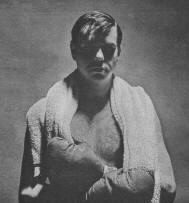 notorious
– Factory. Saturday was cold and dreary, and
John played different music than the usual Cherry Grove fare while we sat around
the house. This is where I first heard Netania Davrath's recording of
Songs of the Auvergne,
which while not Judy Garland, had a hallowed niche in the classical part of the
gay music Hall of Fame.
notorious
– Factory. Saturday was cold and dreary, and
John played different music than the usual Cherry Grove fare while we sat around
the house. This is where I first heard Netania Davrath's recording of
Songs of the Auvergne,
which while not Judy Garland, had a hallowed niche in the classical part of the
gay music Hall of Fame.
Arron G.
Arron's costume character had started out being Romeo, however, by the time it was pulled together, the predominance of hunter green and Arron's husky build dictated that he was a better Robin Hood. John was a wizard in display work, and his masterpiece that afternoon was a costume for a very tall and muscular Aussie, who was one of the summer celebrities in the Grove that year. John created an ornately fashioned papier-mâché lion's head and matching tail, both of which he sprayed brilliant gold. The rest of the lion was the magnificent Aussie in a bikini, sprayed in the same gold from head to foot. The incredible costume and his terrific body, all shining gold, was a knockout.

The house was on the bay side of the Island, and this may have been the party when a group of people costumed as Neptune and his court of tritons arrived on a decorated boat. However, the high point of this festivity was supposed to be when a very heavy drag with a perpetual five o'clock shadow entered as the fairy Tinker Bell - dressed in ruffled tutu, wig and tiara (of course) and carrying a sparkling wand. For the full effect a cable had been strung from the roof of the neighboring house to the deck of the host's house. At what was intended to be the culminating grand arrival Tinker Bell hooked onto the cable, a spotlight caught her as she began her ascent......and then the cable snagged. This left a very hefty Tinker Bell twisting in a stiff wind over the party while her wand burned out. She struggled but couldn't get going again and finally was ignored by the multitude below, and someone went to hunt for an extension ladder. I never did see the landing.
The previous year I had been the guest of a friend for a couple of weekends, but this year I had the use of a room in the Cherry Grove Hotel every weekend in return for working at a friend's shop in the village a few days a week. In most of the years that followed I spent a week or two on the Island, and my last year out there I was one of a group of guys that rented a house in the Pines for the season. Whether for a week or a season, it was a stretch of golden summers in a beautiful and special place.
POP!
While I'd heard about poppers, no one I'd slept with had ever used them. Thus, they had remained one of the untasted fruits from the Tree of the Knowledge of Good and Evil. The summer of '63 three other guys and myself shared a room in Jimmy Merry's hotel every other weekend. While were were all unpacking one Friday night, I noticed that the guy I was sharing a bed with had what I took to be the fabled, tell-tale little yellow box tucked in a corner of his suitcase. It was, we did, and they lived up to their advanced billing.
The original popper was a very small, fragile glass tube containing a tiny amount of volatile amyl nitrite liquid, and this was rolled into a protective layer of cotton which was bound tightly in a wrapper of gauze. It looked like a miniature sausage and was about an inch long. When these were crushed between your fingers they made a popping sound, the liquid vaporized and you pressed the "sausage" to your nostrils and sniffed the vapor. Oxygen-enriched blood sped to the brain, producing a "rush" – a sensation of dropping off into space – a warmth surged through your body, and the muscles of the anus relaxed (unfortunately despite feeling bigger than the Empire State Building, your dick could sometimes decide to relax too.) The strongest effects are short-lived, a minute or so, but having received this kind of boost the ensuing sex was likely to be rather terrific.
Inhaling amyl nitrite vapor had been used as an emergency relief for angina pectoris since the 19th century. The only brand of poppers I ever saw for many years was manufactured by Burroughs-Wellcome. They came in a distinctive yellow box, packed twelve per box, and the individual crushable capsules were wrapped in a brilliant yellow mesh. The medication was sold over-the-counter for almost the entire decade of the Sixties, and at mid-decade cost either $1.64 or $2.64 a box, can't remember which. A drug store on Sheridan Square, just south of the cigar store on the corner, used to keep a cardboard carton containing a gross of the individual boxes next to the cash register on weekend nights because sales were so brisk.
Later, when they became harder to get, the vaporoles were quickly jammed into an inhaler after they were crushed – not an inconsiderable feat – which meant that each one could be made to last for awhile. Guys bought decongestant inhalers at the drug store removed the medicated "wick" and used these at first. The Benzedrex brand was preferred as the inhaler was easy to disassemble, and had a barrel slightly larger than that of other brands, which made it easier to slip the crushed amyl nitrite vaporole into. Later on metal inhalers especially intended for popper use appeared for sale in head shops and sex stores.
(I would enthusiastically recommend Esther Newton's
book Cherry Grove as a terrific history and
sociological study of Cherry
Grove.)
MISS ELLEN AND HER SISTERS AND DAUGHTERS
Miss Ellen was the flower of ante-bellum matronhood, even though she sported
a heavy five-o’clock shadow. According to her oral autobiography Miss Ellen
was born Richard O’Connor in Bayou Thibodeaux, Louisiana. Her Southern accent
seemed more imitation than life, but that may have been because Cruel Fate
transported her at some young age to live with a maternal aunt and her
husband in the Bronx.
Miss Ellen & Daughter Scarlett, from GWTW
I never saw Miss Ellen in drag or even pictures of her in drag, however, she
lived her life as a never-ending spin-off of Gone With the Wind,
and her name was taken from the character of Scarlet O'Hara's mother. And so
was her persona. Despite the lack of visible hoop skirts, Miss Ellen lived
in what I would characterize as verbal drag and this costuming she rarely
abandoned. Though Miss Ellen always had to announce that she was about to
"pick up mah hoop skirts and flee the Yankees," (which meant going back to
the Bronx), her social life was in Manhattan centered on a wide network of
friends, who were either "sisters" or "daughters." The former title was
casually conferred, but Miss Ellen's "daughters" were all guys she had
befriended in their early twenties and for whom she gushed a fountain of
maternal solicitude. And much of it, from what I saw, was often intelligent
guidance and advice. She did her best to steer one of her daughters out of
the clutches of a doctor who had gotten the young guy hooked on drugs, and then
began demanding sex for the drugs. She was unsuccessful and Terry ended up
in a rehab, and reappeared in the city a couple of years later looking far
older than his twenty-two years and with dead eyes. But he was alive and
able to make another start. 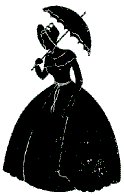
After a brief getting acquainted period Miss Ellen decided I was going to be
a daughter. However, having just turned twenty-five and with a lot of
experience packed into my three years in New York City, I wasn't having any.
Daunted for only one unhappy moment, Miss Ellen then scooped me into her
family as a sister. Thus, Miss Ellen (or Dick as I just as often called her
on non-family occasions) and I began a friendship that lasted years.
As far as I remember Miss Ellen always worked jobs as an assistant
bookkeeper, though he almost never even mentioned work. He was living with
his "mother" and "father" (actually the aunt and her husband who raised him)
in the Bronx near Yankee Stadium and from his tales they totally accepted
his being gay - though I don't know what they thought of Miss Ellen. He had
no romantic relationship in the entire time I knew him. It never occurred to
me at the time that the persona and the world according to Miss Ellen may
have been the brightest part of his life. In retrospect this seems a profoundly
stupid oversight.
Ms. Ellen's age was located somewhere in the mid-thirties, as I recall;
however, treacherous family speculation agreed that it probably could have
more likely been found in the lower forties. Some of her stories
unintentionally seemed to support that evil thought. And stories she had:
Miss Ellen had daughters and sisters everywhere the white man had cut down
the trees and set up housekeeping in America, and it sounded as if she had
visited each of them at one time or another; then there was the extensive
New York branch of her family with roots going back forever and their
doings; finally there was her life as an active tearoom queen. She spun out
stories with relentless enthusiasm, and except for the occasional tragedy -
such as the downfall of her sister, Serafina - they were rollicking, ribald
and side-splittingly funny. Though Miss Ellen was camp incarnate, she had
almost none of the nastiness and negativity that often went along with it.
She had been blessed with wonderfully upbeat sense of humor, a quick wit and
an incredible gift for spinning a story and turning a phrase. Once she ran
into a sister she hadn't seen in a long time, and found this former "lady"
turned out in full leather gear. After itemizing the articles of leather
apparel in a cadenza of increasing amazement, she ended by proclaiming: "My
dear, she looked like a purse!"
Poor Serafina, though. She was a one of Miss Ellen's dearest and earliest
sisters, and along with Miss Kervajian (a successful Armenian-American
businessman by this point) they had been what sounded like an inseparable
trio in their younger days. Serafina, was a very overweight Italian-American
who lived with her mama in Brooklyn, and whose "love life" consisted of
giving quickies in tea rooms.
Magically, however, one of her numbers became smitten with her, pursued her
out of a tearoom and courted her. Serfina was caught
in the net of love at last. Her adored Oscar was a British merchant seaman
who had jumped ship, and to the dismay of Serafina's friends she set up
housekeeping with him and lavished presents on him as well. Oscar had no
money, no job and no legal status and worse he was in his late forties and
hardly a looker by any stretch of the imagination, I gathered. Miss Ellen
and Miss Kervajian scathingly referred to him privately as the alte kaker
(Yiddish for Old Fart.)
Despite having a not very well paying job, according to Miss Ellen, Serafina
was spending what Miss Ellen always referred to as "the Yankee dollar" like
they were going to stop printing them tomorrow
Miss Ellen and Miss Kervajian did not see this relationship as "a flight to the moon on gossamer wings," but an elevator in free fall. Serafma was hearing none of it. Even moon shots return to earth, of course, but unfortunately this did turn out to be the free-falling elevator.
Serafina returned to the conjugal nest after work one day to find the hi-fi and other expensive gadgets missing, her credit cards were missing, and ditto the balance of her checking account. And ditto Oscar, of course.
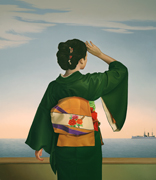 Serafina went into a decline so severe that for the first time since Miss Ellen
had known her she was losing weight. Between bouts of depression she would have
manic bursts of hope that sounded straight out of Madama Butterfly.
Finally, a note from Oscar posted in Australia: He was a sailor after all, he
had to go back to the sea ...blah, blah, blah. He had used the money to buy
forged seaman's papers so he could get a place on a ship. He would pay Serafina
back, of course. She had been a good old pal and he'd never forget her. And some
day....
Serafina went into a decline so severe that for the first time since Miss Ellen
had known her she was losing weight. Between bouts of depression she would have
manic bursts of hope that sounded straight out of Madama Butterfly.
Finally, a note from Oscar posted in Australia: He was a sailor after all, he
had to go back to the sea ...blah, blah, blah. He had used the money to buy
forged seaman's papers so he could get a place on a ship. He would pay Serafina
back, of course. She had been a good old pal and he'd never forget her. And some
day....
It had been a set-up from the get-go. This letter was probably intended to get Serafina to call off the cops if she'd gone to the law
.
Unfortunately the similarity to Madama Butterfly was not quite finished.
Serafina turned on the gas and put her head in the oven. And she wasn't checking the lasagna.
The sad tale of Serafina was not one of Miss Ellen's cutting room floor episodes from GWTW, of course. It was from another cycle of stories about her life, the New York chronicles - the tales of her days as an Irish step dancer were priceless, and ribald enough to risk being knee-capped by the IRA, while her adventures in the tea rooms were funnier than any French bedroom farce.
Still, Miss Ellen's act could be overwhelming. In a group she wasn't very often Dick instead of her Miss Ellen invention, mostly she narrated and lived in a reality transformed into a world of shes.
Sometimes one of the friends she called sisters would grow tired of it all, and make an exasperated remark - and then everyone would be uncomfortable for awhile. Over a few years we developed a private relationship that had less of Miss Ellen in it and more of Raymond O'Hara, but it was slow going. I didn't know anyone else who did it. In a couple of years the tone of a lot of gay life was becoming obviously different, and even Miss Ellen's daughters as they became more confident didn't want a gay "mother." The times they were a-changing, and Miss Ellen was not - and it seemed to me could not. Many of her stories by now were in endless rerun. There was one painful incident that highlighted this for me. Miss Ellen was with Aaron's crowd of friends one day and carrying on full tilt in her usual mode, totally unaware that she was short circuiting any conversation. Suddenly Chris Stone, one of her "daughters", interrupted her angrily, "For crissake, Richard, cut the 'she' shit!" Aaron immediately said, "Yeah, Dick..." and added something to the effect of, "why don't you just let it go once in awhile and relax." Several other people grunted agreement or said, "Yeah." Miss Ellen was stunned. Aaron and his friends turned the camp off and on again, however, Miss Ellen, could rarely switch from camp mode to just plain everyday mode.
I don't remember if we ever discussed this incident, but by the mid-Sixties Dick's visits with me dwelled on his days with Serafina and Miss Kervajian, and times and people not in New York. By then I was no longer part of the crowd of people through whom I'd met Dick, but it was clear that he no longer saw much of them either. In the latter half of the Sixties and early Seventies we were like ships passing in the night: He left New York to move to Akron, Ohio where he had a "daughter" from years back, he returned after a year or so, I had a job where I traveled a great deal; he then moved to Fresno, California where there was yet another "daughter" or "sister." I did exchange letters with him once or twice a year. Only one or two people we had known together ever wrote to him
.
I remember two visits from Dick in the early Seventies sometime. During the first, after he referred to me as his "sister" several times, and I asked him not to call me that. He said something like: But you are my sister. My response I clearly remember was, "No, I'm not, Dick. I'm your friend. And I'm not a she." I couldn't read his look, whether it was confusion or what. However, I knew right then that it had been the wrong thing to say. Even if I hadn't shouted at him as Chris Stone had done, I had yanked the rug out from underneath him. "Friend" just didn't do it, I don't think. He needed a "sister," probably. And maybe he still needed to be Miss Ellen though I had been calling him Dick for years.
The last time I remember seeing him he had just returned from New Orleans, the place that had played such a big role in his Miss Ellen history, and I think that was where he was considering leaving New York for next. In the mid-Sixties we had both known a very pleasant guy, Bill Nelson, from Iowa. Bill was a bit reserved, and when he left New York to go back to Iowa and finish college I thought he'd stay there. We'd exchanged letters once, maybe twice and then we lost touch. It turned out that Dick had discovered him in New Orleans, tending bar in a gay place. I would never have imagined this for Bill in my wildest dreams. And Dick went on and on filling me in on how Bill was still nice, but so outgoing now, and handsome, and all the guys loved him, etc., etc. And as he talked Dick began to sound the Southern matron: proud as could be, waxing ecstatic over the social success of one of her daughters or sisters. And so caught up in spinning out the story that he looked quite Miss Ellen again.
Sometime shortly after this he moved once more. New Orleans, perhaps. I hope so. I moved to a new apartment. We lost touch completely, and I never heard another word about him.
THE ELEPHANTS' GRAVEYARD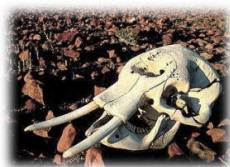
Miss Ellen/Dick was one of the funniest people I ever met, more than that he was an essentially kind and good person. And his "mothering" was his own style of mentoring. To think of how his life in the city withered away is very sad. His shtick could seem relentless and become annoying without a doubt. Times changed, and he didn't; and during these years he became middle-aged, if indeed he wasn't already middle-aged when I met him. He wasn't at all a drinker or bar person, so not even the exile of a "wrinkle room" could have been in his cards. How much slack should his younger friends (including myself) have cut him, and, on the other hand, at what point would we have become patent phonies, enduring duty visits to someone we saw as a living fossil?
What place was there for men of a "certain age," especially when much of the gay lifestyle was changing?
There was no Community Center, of course, nor any other place for older gay men. There were gay men in their late forties and fifties I saw in Cherry Grove over the same period who fought back the years with a flood of booze and ill will toward all, but they had the money to preserve their own private Fifties. I remember back in '59 when one of Bob Manahan's younger friends, Steve, had asked quite earnestly when we were in Lenny's, "But where do all the gay men go to in their forties?" Someone said that there was the equivalent of an elephant's graveyard, and someone else had suggested that it was the New Colony bar, which got a laugh. Steve's question may well have been provoked by anxiety: Though just twenty-five he was almost totally bald, and this with his thin, sharp-featured face and slight frame suggested he was much older. For my part, I had never so much as touched the door of the New Colony until 1963, grimly imagining that it opened onto a ramp which lead down to something like an enormous dark pit full of bones.
DELIVERED FROM HELL'S KITCHEN
In the Spring of '63 – after about a year and a half in the House of Flowers – I moved back to the Upper West Side, sharing an apartment with a series of roommates, on West 81st Street, almost across from the building where Milton and I had lived before. It was the ground floor rear apartment in a brownstone, which meant that it was the "garden" apartment. Like many other so-called gardens in shabby neighborhoods it was a rather desolate space, although it did have a small, geriatric peach tree which managed to put out a small number of blossoms for a few days each spring. Of course, being on the ground floor, it had metal grills on all the windows and the door to the "garden," and more than once I looked out and saw guys climbing the fences and prowling up the street through the back yards. The "garden" boasted a view of the rear of the Endicott Hotel up on Columbus Avenue, one of New York's early welfare hells. Sitting in the backyard on broiling summer nights the fire escapes of the hotel at the end of the block looked like a scene from Calcutta – scores of desperate people out on them trying to get some relief from the heat – drinking and fighting, yelling and screaming and prostitutes roaming up and down the metal stairways selling themselves.
One rather macabre cause for celebration arose for gay men during this period. On March 1, 1963 – oh, day of blessed memory – Lee Mortimer, the infamous homophobe gossip columnist for the Daily Mirror, was taken from us. The following night there were some spontaneous parties to celebrate the occasion, two of which I was happy to attend.
On Friday, November 22, 1963 President Kennedy was assassinated, the office closed at the announcement of his death. As the staff of K-S was leaving, my boss called me into his office. He informed me that I had given incorrect data to one of the higher ups in the firm, and as it was obvious after two years that my heart wasn't exactly dedicated to media research and analysis, he had been told to fire me. Under the circumstances I was too numb for this bit of news to matter, but after the days of national shock and mourning passed, I was little short of delighted. Hallelujah!!! Two years in a monkey suit doing toad work was enough, and in their kindness and mercy the gods had lit a stick of dynamite under my ass.
My parents unexpectedly announced they were descending at Thanksgiving with a small group of friends to see a Syracuse football game that was being played in Yankee Stadium. Alumnus or not, I had less than zero interest – on the appointed day my lack of enthusiasm was punished by an afternoon of snow squalls. Spending the long holiday weekend with my parents had been an even less appealing prospect than the football game, but the presence of the other couples and the boozy party atmosphere made it look like the visit would go off without incident. (I had not, of course, told them that I would be out of work in two weeks, as I knew that would become the pretext for a barrage of oh-you'll-have-to-come-home-then. And thank god I hadn't!))
The night before they were leaving as I was saying goodbye to everyone, my father called me in their room.
"Go up to that place and get your stuff, and come back with us," he demanded as soon as we got inside.
That place? Oh right, my apartment. I said, no, it's where I live, my home. If looks could kill, I would have been dog food. He stared at me without saying anything for awhile, then reached in his pocket and peeled off a ten or twenty dollar bill.
"I can't leave you any money when I die, you know," he said as he handed it to me.
I mumbled that it was okay, it was his money.
"They'll just get it away from you."
Who?
"Those people. They'll blackmail you." He went on, and it became clear he meant other gay people, it seemed not to occur to him that this blackmailing was usually an activity of his fellow straights. Hard upon the heels of this came another joyful event.
In mid-December the New York Times printed a jolly article on its front page: "Growth of Overt Homosexuality in City Provokes Wide Concern." Although it appeared as a news story on page one, pinned to recent attempts to close down gay bars, etc., it contained much material that would be characterized as op-ed today. The Times article ruminated on with anxious fretting and a tone of hand-wringing bewilderment, finally finding hope in the fact that as homosexuality had been recognized by the medical profession as a disease that cures could be effected. One should remember that voluntary psychotherapy was not all that was on the cure menu, among the "cures" authorities in the U.S. and the U.K. embraced at this time were commitment to insane asylums and aversion therapy using nausea-inducing drugs and electric shocks, as well. This article - on top of four years of focused and aggressive harassment by the police - was the last thing I wanted to see, the leading newspaper in the city and the nation publicly worrying about the prevalence of homosexuals and looking favorably at "cures!"
Some gay historians pondering the quaint events of gay yesteryear from the relative safety of the late twentieth century have characterized this article as a welcomed breakthrough in press coverage about gays. Just how far up your ass does your head have to be, I wonder, not to grasp that this article would be seen by gay men of the time as anything other than very ominous? The effects of Lee Mortimer's campaign in the New York Mirror to eliminate gay bars from New York were still being felt. I was very afraid the Times article might ignite the flames of a new era of McCarthyite witch-hunting of gays, and I remember only fearful comments about this article. But I and the people I knew then were too benighted, I guess, to grasp how a plainly homophobic article on the front page of the New York Times - America's most influential newspaper – was not the boon of journalistic coverage we should have been devoutly wishing for.
"CHICAGO IS THE WRIGLEY BUILDING, CHICAGO IS...."

Summer ´64 at the new job
From December ’64 through March ’65 my job put me in the Chicago suburbs, or within striking distance of the city for weekend trips. This was the first time I’d gotten to see gay life in any place other than Syracuse or New York.
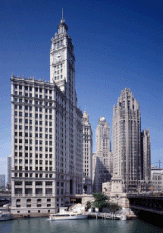
My first assignment was at a church affiliated college in the suburbs, and it was a real eye-opener. Two of the upper echelon college officials, both married, were gay, but were successfully passing – though at least one of them did drop in at the Dome Room of the Sherman Hotel once in awhile, it had a jacket and tie ambiance. Two younger, single administrators were also gay, and both seemed to be identified as queer by at least some of the students. However, the shocker was that the president of the student body was not only gay, but God and everybody knew it! He didn’t wear a placard, nor would he have been in my estimation particularly identifiable as gay, but he evidently had made no effort to conceal his sexual orientation. He was a very nice-looking, intelligent, affable guy who was obviously well-liked – though a few male students made their hostility very public (jocks, of course), I was told. But most of the students ignored his sexual orientation or seemed a bit bewildered by it as far as I could see. I believe that he had even invited a boyfriend to one of the major college social events. And this is 1964.
Chet, one of the young gay administrators took me to some of the bars. One was called the Annex (if I remember correctly) and was on North Clark Street, or near it somewhere, another was the Century near a movie house of the same name. They mentioned another place, which they didn't go because it was a leather bar...maybe it was the Gold Coast.
In the Century I was surprised to run into David B., the nicest member of the clique I had fallen in with my Junior year at Syracuse University. He was living in Chicago. Stranger still, the very next night I ran into Tom R., from the same clique, who was also living in Chicago – and he hadn’t a clue that David lived there too! Tom was the Philadelphia Main Line shithead who had made the observation after we slept together that I would always be queer, whereas he was going to get married, etc. Revenge is sweet: I asked after the wife and kids, but he was embarrassingly bereft of news on the topic.
These places were cruise bars that could have been in New York, but Chet took me to another just across the way and down the street from the Century, the Red Parrot (or maybe just the Parrot), which featured drag acts. While I’d seen drag queens at parties in the Grove, I don’t recall them doing anything other than vamping around and posing, though there was an end-of-the-season stage show with drag acts which I’d never seen.
The Red Parrot was my introduction to drag queens as stage performers. While the local audience received them with enthusiasm, I thought the first two were so effing awful that I would have been entertained only if they had vaporized before our very eyes. But then Robbie, a buxom, black queen came out and put on a show that could have made a dead man cum. I think he may have lip-synched to an Etta James' song, but it doesn’t matter whose it might have been, for he did the number with a style and wit that was completely his own, a performance so unique that lip-synching was the least of it.
However, over the next few decades most gay drag acts I saw rivaled the
later phenomenon of straight karaoke performances as a
magnet for the massively untalented. Female impersonation rarely saw talent
like Robbie, and comedy drag was done best by straight performers such as
Milton
 Berle, Flip Wilson and Jonathon Winters. Gay drag performers, even of the
caliber of Charles
Pierce for example, seemed very limited
–
trapped in a repertoire from the camp traditions of gay life
and a fandom of easily satisfied gay audiences. Gay drag acts
were rarely anything other than the same ol' same ol'. On the other hand, the Ballets Trockadero
de Monte Carlo, and the Cockettes (at least on their
home ground, I hear) were great
entertainment, and the Hot Peaches and other acts could be top class.
Berle, Flip Wilson and Jonathon Winters. Gay drag performers, even of the
caliber of Charles
Pierce for example, seemed very limited
–
trapped in a repertoire from the camp traditions of gay life
and a fandom of easily satisfied gay audiences. Gay drag acts
were rarely anything other than the same ol' same ol'. On the other hand, the Ballets Trockadero
de Monte Carlo, and the Cockettes (at least on their
home ground, I hear) were great
entertainment, and the Hot Peaches and other acts could be top class.
"A lack of talent is not enough," remarked Gore Vidal as he walked out
of the theatre at the midpoint of the Cockette's 1971 New York opening,
as did dedicated fan John Lennon and a large part of the audience.
Chet and I also went to Hugo’s, a place near Chicago’s Old Town. I was surprised to see that the place allowed dancing, at least in the form of a group dance called the Madison. It had already had trouble with the cops, and was closed not long afterward, Chet told me.
In 1961, Illinois had become the first state in the nation to adopt the recommendations of the American Law Institute and pass a comprehensive revision of its criminal code. One of the revisions – as it was described by gay guys I knew – "made sodomy legal." Exactly what this meant was not clear. However, given that New York City was in the grips of a major campaign of gay repression at the time, my recollection is that this news passed from view quickly and ignited no flame of optimism. When I ended up in Chicago in the fall of '64, what I saw and heard indicated that while gay sexual relations may have been decriminalized the harassment remained.
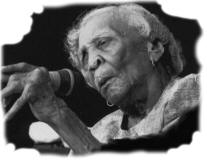 (right) Mama Estella Yancey
(right) Mama Estella Yancey
Later I met Phil in the Century bar. He was a research scientist at the University of Chicago who was deep into a project that involved living chicken hearts – minus the chickens. It sounded nasty, and I didn’t even want to listen in the event I was ever questioned by the ASPCA. As far as I know he never won the Nobel Prize with that stuff, but since I don’t even watch the Oscar awards, I could have missed it. Despite his ghoulish professional life, Phil was a warm, charming guy whose interests went beyond the Frankenstein world of keeping chicken innards pulsating in vitro. He served fried eggs and petit fours for breakfast, didn’t have a curtain on his shower, liked folk music (not the pop stuff) and jazz, and introduced me to Studs Terkel’s radio programs. (Read Terkel's Division Street for excellent vintage Terkel. It still holds up.)
A few times we went to hear a very old, frail blues singer - a tiny, black woman who was practically carried on stage. She had a raw, intense voice and a peculiarly sharp diction and delivery. I was enthralled. I think she was Mama Estella Yancey, though I don’t truly recall her name.
I also spent almost two months on assignment in Palm Beach, Florida. The gay scene there seemed to have the same sneaky, depressing kind of atmosphere as that of downtown Syracuse in the late Fifties. I did end up at a party in a large apartment on swanky Worth Avenue (or is it Worth Street) given by a dress designer named Ptolemy...it came off more than a little like a gayer version of the party that ends Fellini's La Dolce Vita - spiritless decadence, too much booze and contagious boredom.
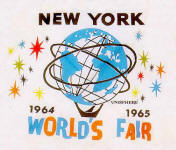 In
New York leather had become more visible and more acceptable. But the "college boy/Ivy League" look was definitely
heading the way of the dinosaur. There had been a brief lightening up after a couple of years, but then as
the mayor tried to get the city cleaned up for the 1964 World's Fair
In
New York leather had become more visible and more acceptable. But the "college boy/Ivy League" look was definitely
heading the way of the dinosaur. There had been a brief lightening up after a couple of years, but then as
the mayor tried to get the city cleaned up for the 1964 World's Fair
64/65 World's Fair emblem
this became an excuse for renewed vigilance against gay people and places. The heat was on again. Gay bars were closed, and according to Frank O'Hara's biographer, Brad Gooch, so were some coffee houses that held non-profit poetry readings and movie houses showing unlicensed films, including Genet's Chant d'amour.
More and more it seemed that this would be the way of life in the city, and not just a temporary dislocation. My work travels left me out of touch with the bar closings, and when I came back to town I had to check up with someone before I went out. There was always Julius's, of course. But by this time the appeal of its cobwebbed beams and nostalgia decor had paled; and more to the point, I had no patience with the place's anti-gay atmosphere. For my New York money I wanted a real gay bar, I could find plenty of tight-assed places on my journeys around the country. Somewhere just before mid-decade I ceased dropping into Julius's at all. After all, if I wanted homophobia up close and personal, I could stay home, sit in comfortable chair and call my parents.
A person in his twenties remarked to me many, many years later that it was very "brave" to have lived a gay life in New York during these years. I'm not sure how much bravery was involved. I won't demean the men and women of those years (including myself) by saying, "none", but a certain amount of it was more like bullheaded endurance. Many gay guys came from out of town specifically to enjoy what had been the thriving gay life and to benefit from big city anonymity. Having made the move for those reasons helps explain why not a few people weren't willing to roll over and play dead.
However, I do think that even before the purge in '59/'60, fewer people went out then because of the furtive atmosphere of gay life - and the real risks if caught in a raid.
Popular music went through considerable changes from
1960 through 1964. Rhythm 'n' Blues had already become Rock 'n' Roll, and the latter
had become Rock, which would eventually fragment into so many subcategories and
hybrids as to become a virtually meaningless term. (Rock is also one of
the factors that contributed to the decline of jazz, as it siphoned off its
college audience.) The Top 40 format had
been invented in the late Fifties, and was by now the mind-numbing standard on
all AM music stations. Founded in 1959 (as Tamla), Motown records, a black-owned Detroit
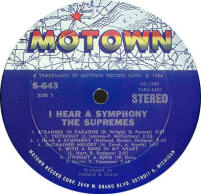 company featuring (and carefully developing) a roster of black artists was an increasingly large presence
on the pop music scene
– by '64 it was the largest independent label. Its group the Supremes were making hit after
hit. New black companies and artists sprang up in other cities, following
the Motown model and developing and promoting distinctive sounds.
If you deleted Motown artists and other similar black performers from the Top 40
of the early years of the Sixties, you were left with consistent chart
repeaters Bobby Vinton, Elvis Presley, Peter, Paul and Mary, Brenda Lee, Bobby
Darin, the Beach Boys, Dean Martin, etc. plus the beginnings of folk
rock/protest.
company featuring (and carefully developing) a roster of black artists was an increasingly large presence
on the pop music scene
– by '64 it was the largest independent label. Its group the Supremes were making hit after
hit. New black companies and artists sprang up in other cities, following
the Motown model and developing and promoting distinctive sounds.
If you deleted Motown artists and other similar black performers from the Top 40
of the early years of the Sixties, you were left with consistent chart
repeaters Bobby Vinton, Elvis Presley, Peter, Paul and Mary, Brenda Lee, Bobby
Darin, the Beach Boys, Dean Martin, etc. plus the beginnings of folk
rock/protest.
And, of course, the Bossa Nova/Brazilian craze – even a year after the arrival of the Beatles in the U.S., the trio of Stan Getz and João and Astrud Gilberto (sax, guitar and vocals respectively) walked away with the '65 Grammies for Best Album and Best Single (The Girl From Ipanema, one of the most well-known Latin jazz cuts of all time.)
In the wake of the Beatles arrival in the U.S. in early '64 U.S. music was swamped by the subsequent "British Invasion," and for several years to come American artists would struggle on the charts. But not the Motown stable and similar black artists, though. They were the only part of the U.S. music scene to consistently compete at the top and to continue to develop and broaden their market. At this point R&B and soul music had a fan base of blacks, some urban white teenagers and an increasing number of white gay men; whereas, the existing varieties of rock drew largely on young whites outside of urban areas and white middle class college students – black rock performers were very few. There was some cross-over buying and listening, of course, but these divisions tended to harden over the next fifteen years even as their original audiences grew older. White straight males invested their money in rock purchases; blacks and gay males into soul - and later, disco and dance.
It was a division which would make rock music fandom a natural accumulating place for white homophobia and racism as black and gay minorities attained high visibility in the 70's.
Perhaps as a reaction against the Top 40 formula, which made all AM music stations essentially the same, a few white gay men I knew would take a break with the small black audience oriented stations. These played various formats from a mix that included Motown and similar sounds, as well as a rougher style of Rhythm and Blues, artists like James Brown and Etta James, plus gospel and jazz. Rock and soul took over the juke boxes in the gay world too. The artists and types of music represented by the wonderful array on the old Cafe De Lys juke box ('59/60) was history as far as younger gay people were concerned. And despite sold out concert appearances at the Palace on Broadway just after the mid-point of the Sixties, on juke boxes Judy Garland was definitely becoming a relic rather than a living legend.
A great deal of good music was stigmatized as being for "aunties" and "wrinkle rooms." Ironically, one of the few attractions of Carr's, a bar in the late Sixties/early Seventies on West 10th Street with the reputation of being a wrinkle room, was the amount of great classic standards on its juke box. Its other attraction was that it was a perfect place to meet quickly after work if you were cheating on your lover with some Back Street lovin'. It had a separate, semi-private room with tables that got virtually no business at that time of day, which allowed illicit lovers to tongue-suck and paw each other with an animal abandon more appropriate to the back seat of a Chevy circa 1956. Alas, no gay Fanny Hurst has written of it, and we are poorer for that. Andrew Holleran did give a gay senior frisson over the place in a short piece for the September 1, 1996 New York Times Magazine, but it really deserves at least a novella's worth of ripe and steamy purple prose.
There was a series of short-lived dance crazes too, e.g. – the Mashed Potatoes, the Watusi, the Loco-motion, etc. Each was named for a hit single of the same name and usually lasted only a little longer than the hit. An exception was the Twist, which wiggled itself out over a few records to became a national craze, and even underwent a revival a few years later. While the dance itself would seem ludicrous today, it was danceable by everyone - requiring no leading of your partner and no intricate footwork. It made dancing to upbeat music more popular, and it varied the tempo of gay parties, where formerly romantic ballads had been virtually the exclusive fare. The twist was a harbinger, and led straight to free-style disco dancing. However, gay dance bars didn't stand a chance in the current ultra-repressive climate.
It was in 1965 that the FCC changed the regulations under which AM/FM radio operated, and FM radio, as a result, was launched as a truly separate listening band of vibrant stations with more specialized formats. Later several essentially black-oriented stations would draw large audiences of gay white men.
Miss Marmelstein, a one-song character role in the 1962 musical I Can Get It for You Wholesale, had brought Barbra Streisand the kind of magical "instant fame" that is the stuff of Broadway legend. She quickly followed it up with three popular albums - then her starring role in Funny Girl (64-65) – and three more best-selling albums. By 1966 some gay men were already calling her "the new Judy Garland."
As all this was available on the radio, I diverted some of my record buying in another direction. Though I'd first come to New York to see gay life in the biggest city in the world - and enjoy a less repressive environment – the "foreignness" that I had found there became a magnet too. So many people and things were in New York, but not of it that the city seemed to me to be as much a doorstep into the rest of the world as it was the Big Town of American films and fiction. I spent a lot of time doing "research" in record stores, following up references I came across in newspapers and magazines to famous foreign pop singers or folk music that I'd never heard of. Thus, at this point, like the old joke about the faggot whose boast was, "I've seen every movie Ann Sheridan ever made," this one was able to claim having every single Edith Piaf recording - domestic or imported - available in the U.S. And, I had small batches Om Khalsoum, the Egyptian singer whose weekly programs had the largest listening audience in the world, Amalia Rodrigues, the goddess of fado, and some rembetiko, Greek "blues." [And more than half a century later, I'm still at it, and my collection is now huge with Brazilian MPB, Luso-African pop and morna, Arab rai and pop, Bollywood and Indian traditional....etc.]
"THE TIMES THEY ARE A-CHANGIN"
Thus spake – or rather, sang – Bob Dylan. And it is axiomatic that the Sixties was a decade tumultuous social and political changes in the United States. Perhaps the most startling one was the willingness of an ever increasing number of Americans to resort to massive demonstrations and widespread civil disobedience – as well as prolonged rioting and arson and even acts of terrorism to express their anger and demands. As disturbing as the majority of Americans may have found the earliest symptoms of this new turn, it took only a few years before the level of unrest and violence, and the deep contempt so often manifested against police, government and various social institutions, had turned into a nationwide atmosphere of uncertainty and fear.

Black Power, the anti-war movement and Hippies are emblematic of the era, but less spectacular forms of disaffection with the status quo and traditional norms became ubiquitous.
Yippie leaders Abby Hoffman and Jerry Rubin
It was only at the mid-point of the decade that an increasingly liberal
atmosphere began to affect gay people in New York, and not until the end of the
decade that gay rights issues began to have a high profile. A virtual handful of
gay activists with Mattachine connections presented themselves publicly.
As for the New Left, the SDS, and the Yippies - none of these groups
–
really gave
a shit about
gay people. The leaders of the Black Panthers and the Yippies were
as homophobic as mainstream American society. 
(right) 1965 gay civil rights marchers
The mythic free spiritedness and sexual freedom of the Hippies was as thoroughly heterosexual as the Baptist church, and a largely white phenomenon. Gay people were not always a welcome presence on the scene. The Beats had been miles ahead of any of these groups in both the involvement of gay men and their acceptance of homosexuality. The Beats, of course, were not working a political agenda, and these new groups were. Despite all the chest thumping about radicalism, Sixties revolutionary rhetoric and trappings still focused on the conventional Leftist issues of race and social class. The New Left's 1962 Port Huron Statement did not find gay rights a worthy issue. While Bayard Rustin, a major organizer in the black civil rights struggle, was gay, he survived in it and was tremendously useful to it only by virtue of the determined protection of Martin Luther King, Jr. The support and talents of gay black writer, James Baldwin, were welcomed too, but his public presence was not. To the Black Panthers gay men were as evil as "baby rapers," and according to former Yippie leader, Jerry Rubin, homophobia and sexism were alive and well among these supposedly free-wheeling political jesters and radicals. Yippie Leader Abbie Hoffman once characterized Hippies as just a "bunch of fags." (Later on as gay rights activism surfaced Hoffman didn't scruple about wooing gay support.)
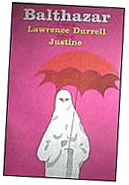
(right) The second volume of Durrell's Alexandria Quartet
Perhaps it shouldn't be surprising that authors and publishers were more adventurous about homosexuality than even "radical" politics. One of the first best selling works to include major gay characters was Lawrence Durrell's four volume Alexandria Quartet. This series had been published in the late Fifties to great acclaim, and their appearance in paperback in the early Sixties widened their popularity. One of the most sympathetic and wisest of the major characters in these books, Balthazar, is a gay male doctor, and a prominent secondary comic character is a gay cross-dressing policeman, who literally becomes a saint. Other minor characters are gay or lesbian, and throughout the Quartet homosexuality is presented as unremarkable. A constant touchstone throughout is the poetry and tutelary presence of Alexandria's gay poet, Constantine Cavafy.
I mentioned in an earlier section that I had two majors in college, and only the basic English 101 course in those four years...and almost no time for leisure reading. My catching up started with Durrell's Quartet and Snow Country by Yasunari Kawabata in 1960 when I was copy boy at the Times.
 While there
was no tidal wave of books focused on gay people, there was certainly a marked
increase, and they received plenty of mainstream advertising and review space.
The first half of the decade saw Sam (1960) by
best-seller author, Lonnie Coleman - among gays his book was referred to as "the gay novel
with a happy ending", City of Night (1963) by John Rechy, A
Single Man (1964) by Christopher Isherwood, Totem Pole (1965) by Sandford Friedman - a superb book, and Ned Rorem's
Paris Diary
(1966). [Rorem's New York Diary appeared in 1967.] The works of gay French
writer, Jean Genêt, achieved widespread prominence in this period in the U.S.,
and a translation from French of Violette LeDuc's lesbian memoir, La Batarde came out
in '65. Hubert Selby Jr.'s 1964 novel, Last Exit to Brooklyn,
received critical acclaim but was denounced as obscene. It was a raw and
violent look at lower class Brooklyn life, and one major section of the book was
about a transvestite and another about a
married man having a gay affair. There were other books, but these
are the ones that I can specifically recall myself or gay friends reading.
While there
was no tidal wave of books focused on gay people, there was certainly a marked
increase, and they received plenty of mainstream advertising and review space.
The first half of the decade saw Sam (1960) by
best-seller author, Lonnie Coleman - among gays his book was referred to as "the gay novel
with a happy ending", City of Night (1963) by John Rechy, A
Single Man (1964) by Christopher Isherwood, Totem Pole (1965) by Sandford Friedman - a superb book, and Ned Rorem's
Paris Diary
(1966). [Rorem's New York Diary appeared in 1967.] The works of gay French
writer, Jean Genêt, achieved widespread prominence in this period in the U.S.,
and a translation from French of Violette LeDuc's lesbian memoir, La Batarde came out
in '65. Hubert Selby Jr.'s 1964 novel, Last Exit to Brooklyn,
received critical acclaim but was denounced as obscene. It was a raw and
violent look at lower class Brooklyn life, and one major section of the book was
about a transvestite and another about a
married man having a gay affair. There were other books, but these
are the ones that I can specifically recall myself or gay friends reading.
Books intended for the gay erotica market became more visible - and better written. In 1966 Phil Andros came out with Stud and Richard Amory, Song of the Loon, and both writers became very popular and sold very well with gay men. There was enough serious gay literature and non-fiction about homosexuality that the Oscar Wilde Bookshop, selling only non-pornographic works, could open the following year.
A
lthough the beefcake photo magazines, their minimal text and captions studded with gay innuendoes and coded language, flourished, and One, the serious political voice, was still being published, I believe, there was a new gay mag on the block. Drum, which I remember as being a definitely non-glossy production, came into my hands in 1965. It was mix of news items, comments and opinions - giving the finger not only at the oppressive straight world, but to gay targets as well, plus cartoons and photos, all done up in an irreverent manner.
(right) Joe Cino
Joe Cino had opened the Caffe Cino in the late Fifties at 31 Cornelia St. in the Village. A good looking gay guy of Sicilian descent, he had come to New York from Buffalo at age fifteen to be a dancer, but ended as one of the originators of Off-Off Broadway theater. According to a friend, his landlady at the Caffe Cino was a Sicilian and rented the store to a paisan for $125 a month, which allowed him to operate with very little ready cash. He was open only at night and served regular coffee - 25 cents, espresso a little more, grenadine – 75 cents, pastry – 45 cents, no wine or liquor, and no charge for the show. The cast passed the hat after the performance.
In 1964 the Cino ran what I believe was not the first of its gay plays, but the first to receive wide attention. The Madness of Lady Bright was a milestone for a specifically gay theater tradition, which was carried on by TOSO and GLINES in the years after Cino's death in '67. Doric Wilson, Sam Shepherd, Landford Wilson, Marshall Mason, and many others got a start with Joe Cino.
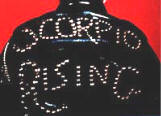
Kenneth Anger's
Scorpio Rising opened at the Bleecker Street Cinema in
1966, and had reruns in the following years. In the same year Rev. Al
Carmines, a playwright, began his tenure at Judson Memorial Church on Washington
Square. Very soon his productions were extremely popular with both straights and
gays; the dialogue and lyrics were witty
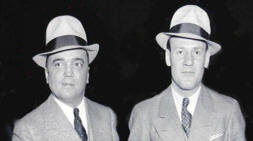 and Carmine's was a master satirical
social criticism. Gay characters and gay material were routine in
his work. I remember one hilarious scene
– though I cannot remember the
production of which it was a part.
and Carmine's was a master satirical
social criticism. Gay characters and gay material were routine in
his work. I remember one hilarious scene
– though I cannot remember the
production of which it was a part.
(right) F.B.I. paramours, Hoover and Tolson.
F.B.I. czar J. Edgar Hoover sang a letter dictation to his real life assistant, Clyde Tolson, who sat perched on Hoover's knee with a steno pad. Rumors of their homosexual affair were later publicly confirmed by Mafia blackmailers.
And then there was that damned war, still being referred to sometimes as the "Vietnam conflict." It had begun with Eisenhower sending "advisors" to southern Vietnam, and then more under Kennedy – until Johnson had inherited a major military commitment – 385,000+ U.S. troops were in 'Nam by the end of 1966. Americans were confused about the war, Johnson was being badly advised, the regimes we were supporting were weak, corrupt and disliked by their own people - and the death toll of American young men was creeping up. And for what? Public protests had begun against the war. In February I went to see Sartre's play The Condemned of Altona with a friend from Fairfield Reading. It was an abstruse and awkward play given a stiff production, but still interesting; however, it wasn't until afterward it occurred to us both that it could have been produced as a comment on the war. And on August 16, 1966 the House Un-American Activities Committee (HUAC, again!) began investigations of Americans who were suspected of aiding the enemy. Anti-war demonstrators disrupted the meeting and 50 were arrested.
One of the best known events of these years was the incredible blackout in November '65 that put New York City, and much of the Northeast into total darkness for days. But I was out of town on an assignment at Denison University in Granville, Ohio and had to be satisfied with reading about it.
"BIG CRACKDOWN ON PHONY PHYSIQUE MAGAZINES"
Of course not everyone - by any means - was "a-changin'" as far as homosexuality went. The above headline comes from an editorial in the Sept.-Oct. 1966 issue of Dan Lurie's Muscle Training Illustrated magazine.
"....as every strength-athlete and weight-man knows, there are a lot of so-called bodybuilding magazines on the stands today which have absolutely nothing to do with bodybuilding. They exist only for one purpose - to cater to the twisted tastes of an unfortunate segment of our population who get their "kicks" by looking at photos of naked or near-naked boys...any half-wit can tell at a glance that the soft, girlish-looking men pictured in these magazines are not bodybuilders or weightlifters or athletes. It is doubtful if any of them ever did anything more strenuous than pulling on a pair of skin tight jeans....
Cover of Sept.-Oct. '66 issue"Two years ago the federal government began cracking down on homosexuals as poor security risks and more recently began kicking them out of the armed services. Some photographers have been indicted, others have had all their photos seized, newsstands have been raided and more than one pornographic publisher has received a jail sentence. The axe is falling in all directions and this is only the start. If your photos appear in any of these phony physique magazines you could be next on the list..."

It is interesting that the coverman on this issue of Muscle Training was "Zabo" Koszewski, a popular and prize-winning California bodybuilder of the Fifties and Sixties. Though reputed to be straight, he had frequently posed for Bob Mizner and his photos had appeared in Physique Pictorial – the publication that was the mother of all those little beefcake mags being excortiated.
* * *
(left) Mike Mentzer was renowned in bodybuilding circles as much for his vocabulary and propensity to quote the philosophy of Aye Rand as he was for the dimensions of his impressive physique.
Not to worry. Within another decade and a half an interview with Mike Mentzer, winner of the Mr. America and Mr. Universe contests – and straight but unflappable – was the lead article in an issue of The Advocate, complete with cover picture, natch.
Many of the other books that show up in my life in the mid-Sixties reflect the intellectual interests and enthusiasms of those years, especially on college campuses. Magazines and newspapers from the scholarly to supermarket rags eventually weighed in with their articles on these topics. Most people probably got their information from publications such as Time and Newsweek, articles suitably brief and already into the news-must-be-amusing mode, which allowed a great part of the American public to decide in ten minutes that they were well enough informed to arrive at a negative opinion about almost anything. Eventually topics would filter down to provide fodder for TV comedians and one-liners on sit coms, further reassuring many Americans that they had certainly been right to be dismissive.
Psychotherapy East and West, by Alan Watts, who became the national popularizer of Zen, was the first in a string of books I read on Zen, I believe; another was Phillip Kapleau's Three Pillars of Zen.
William
Barrett's Irrational Man (1958) introduced Americans to existentialism,
and I had picked up a copy sometime after the paperback came out in '62.
picked up a copy sometime after the paperback came out in '62.
(right) Irrational Man, '62 paperback cover
In the mid-Sixties I worked through a pile of philosophy books and novels from the realm of French existentialism: Jean Paul Sartre's novel Nausea was my onto The Philosophy of Jean Paul Sartre by Robert Cummings for help, and actually found it enjoyable, and then trudged through To Freedom Condemned. Albert Camus was a less ponderous read, especially his non-fiction: I read The Stranger, which every college kid in the Sixties read, and The Fall, and The Myth of Sisyphus and Other Essays.
 I
was still reading those two authors sometimes considered as "tainted" with
Jansenism, François Mauriac and Graham Green: Thérèse
by Mauriac (and his follow-up short stories about the protagonist, whom he seemed unable to put aside),
I
was still reading those two authors sometimes considered as "tainted" with
Jansenism, François Mauriac and Graham Green: Thérèse
by Mauriac (and his follow-up short stories about the protagonist, whom he seemed unable to put aside),
(left) Thérèse, '66 paperback cover
and by Green, The Heart of the Matter and The Third Man. (The latter a best selling mystery which had acquired a parallel life as a superb film (1949) starring Orson Welles. Its theme music, played on a zither, had been a major hit back then. It was a real ear worm, but at least it was not played on the glockenspiel.)
Frederick Prokosch, who had tantalized my libido so seductively with The Asiatics as a youngster, came out with A Ballad of Love. Other gay writers I read in these years were Paul Goodman's autobiographical novel, Making Do, Tennessee William's poems, In The Winter of Cities, and Arthur Rimbaud's poetry, Illuminations, and A Season in Hell & The Drunken Boat, plus Jean Genet's Our Lady of the Flowers and Miracle of the Rose.
 (right)
Witches' Sabbath
'66 paperback cover
(right)
Witches' Sabbath
'66 paperback cover
Rilke's Sonnets to Orpheus were a sort of esthetic high ground, from which eminence I dived into The Story of O, a wildly popular bit of literary pornography (by Pauline Reage and from France, of course), The Wheel of Fortune (a pot-boiler memoir by Piaf – I would have read her grocery list) and Witches' Sabbath by Maurice Sachs, a despicable gay petty swindler and sponger who was involved in French artistic circles at the advent of WWII and spied for the Gestapo.
In 1966 I had a very brief affair with a sweet guy named Jerry, one of hundreds of young gay men who had a role in The Fantasticks before plunging into the obscurity of permanent waiterdom. I took him to see the Bunraku – the wondrous Japanese puppet theater. And he took me to see the very funny and lively musical, Superman, which I was crazy about – and still am. Soon we had to part, most likely never to bed again, I for a teaching assignment in Florida and he for the promise of stardom somewhere in the Trans-Hudson Outback. A couple of days before I left we met for a quick drink in the early evening in a Village bar. As a parting gift I gave him a copy of the Rubayait of Omar Khayyam. (My spellchecker suggests that I might consider the Rubbermaid of Omar Kayak, and perhaps I should have.) Besotted with lust, I embellished the book with a florid inscription, which in a crisis of over-confidence and with a desire to impress, I translated into French – a language my college teachers had implored me to drop before I single-handedly brought it to the verge of extinction. The translation was not just wrong, it was grotesquely wrong: Instead of asking rhetorically, must we say it wasn't love because it couldn't last, I mangled this into something closer to, must we say it wasn't love because it couldn't stay hard. Poor Jerry must have been very puzzled, as he never had a problem in the hardness department.
Really, what a jackass! I cringe when I think that book may still be in existence somewhere, and thank the gods that at least it wasn't The Prophet.
THE "RED MAYOR" OF FUN CITY
I was often out of the city for several months at a stretch during these years. I'm not sure how much I missed though. It had looked for a brief while that the anti-bar campaign might be lightening up when along came the damned World's Fair, which was heralded by announcements of a new clean up campaign. However, the World's Fair was Mayor Wagner's swan song. By this time the Democratic party in New York City was in a shambles as Tammany Hall finally collapsed, and the Reform Democrats raised hell for the Old Faces and the old ways of the party. Thus, "Handsome John" Lindsay, a rich, sophisticated Republican with movie star looks swept into office as the candidate on the Republican and Liberal tickets, and was supported by disenchanted Democrats and independents too. And, rather rapidly the city atmosphere that I tend to think of as a black and white Fifties movie began to change in many ways.
 [Those familiar with New York State politics are probably aware that the Liberal
Party was a third party that served as a home to liberal-minded voters who did
not wish to affiliate with the New York Democrats. It was a
progressive/labor-oriented party which had been formed in 1944. I had
joined it when I became eligible to vote, and I remained a member until the early Seventies.]
[Those familiar with New York State politics are probably aware that the Liberal
Party was a third party that served as a home to liberal-minded voters who did
not wish to affiliate with the New York Democrats. It was a
progressive/labor-oriented party which had been formed in 1944. I had
joined it when I became eligible to vote, and I remained a member until the early Seventies.]
As the years have passed it seems to have become obligatory in some quarters of the gay world to demonize Mayor Lindsay for not having been the epitome of a third millennium gay-friendly vote-seeker and mayor. These were easy to be only long after Lindsay had paved the way by becoming the first mayor of New York to make any public and official gay positive moves. If he fails to delight because he didn't kiss gay ass in Macy's window, sorry, but this wasn't on anyone's menu yet. However, neither was he even remotely a typical homophobe of the era. Like Nelson Rockefeller, a longtime New York governor, Lindsay was a wealthy Republican with strong liberal leanings and anti-gay pandering wasn't high on his agenda. What is conjured up as evidence of anti-gay inclinations (despite an amazing record to the contrary) are the cleanup campaigns in Times Square and Washington Square initiated shortly after his election. Neither of these was an anti-gay crusade per se, though in both cases gay prostitution and meat racks were among the targets, and people who peddle their asses in public, whether for free or cash, are always part of any cleanup campaign - and that's the way it be. Get over it.
 Times Square in '66 was no soft-focus art film of
love-among-the-lowly, even if your idea of a Valentine was a big basket in a
pair of sprayed-on Levis. By this time "the Deuce," as 42nd Street was known,
in addition to the usual hustlers, and prostitutes (drag and female) was
attracting more thuggish individuals (male and female) who were looking to set up
customers for assault and robbery rather than a roll in sack; drunks were
pissing and panhandling all over the place and passed out on the pavement; dope
selling was going hot and heavy (and it wasn't just a little MJ), etc.....and,
of course, the owners of the Broadway theaters, and the restaurants that
depended on middle and upper class theatre-going clientele, were up in arms. The Great White Way, the
Street of Broken Dreams.......and all the other clichés, for which the area was
famous
– was looking more and more tarnished and rather scary as the Deuce's activities
spread up 8th Avenue and its crowd drifted into the streets of the theatre
district.
Times Square in '66 was no soft-focus art film of
love-among-the-lowly, even if your idea of a Valentine was a big basket in a
pair of sprayed-on Levis. By this time "the Deuce," as 42nd Street was known,
in addition to the usual hustlers, and prostitutes (drag and female) was
attracting more thuggish individuals (male and female) who were looking to set up
customers for assault and robbery rather than a roll in sack; drunks were
pissing and panhandling all over the place and passed out on the pavement; dope
selling was going hot and heavy (and it wasn't just a little MJ), etc.....and,
of course, the owners of the Broadway theaters, and the restaurants that
depended on middle and upper class theatre-going clientele, were up in arms. The Great White Way, the
Street of Broken Dreams.......and all the other clichés, for which the area was
famous
– was looking more and more tarnished and rather scary as the Deuce's activities
spread up 8th Avenue and its crowd drifted into the streets of the theatre
district.
Readers of Martin Duberman's book Stonewall may remember that his major drag queen informant, Sylvia Rivera, told Duberman she used to carry a gun for protection when she worked the Times Square area, but she also admitted operating in tandem with a female prostitute to set up tricks and rob them.
So, a cleanup campaign wasn't exactly unneeded. And if you're out there pushing your ass for fun or profit, you're part of what gets cleaned up. And that doesn't make for gay oppression, that's just real life
Washington Square was a somewhat different story. In
my first years in New York it was a popular weekend gathering place
– though
rather rundown
– as well as having a meat rack at night along the railings on
its west side. The streets surrounding the square were also more residential in
those years, and not gobbled up by New York University as they are now. By the
mid-Sixties there'd been big changes in the park. Crowds came now, not just to
see the Beats, but to listen to performers riding on the wave of the folk
singing trend and the emerging Hippy phenomenon, and just to be in the middle
of "where it's happening, man." And along with these came derelict drunks to
panhandle and booze, dope dealers and the usual pickpockets and worse
–
depending upon the time of day. The park was becoming a grassless shambles and
the local residents and businesses were were having conniptions about the noise,
crime and litter. Part of what took the heat was the gay meat rack and drags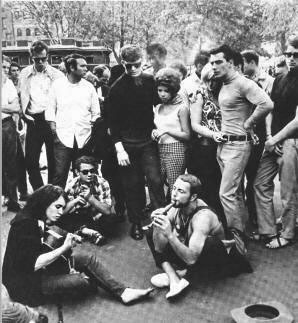 .
.
Washington Square, 60's (Klaus Lehnartz photo)
The answer in both Times Square and Washington Square was the usual recipe of more policemen, hassling and threats of arrest, plus a sweep and carting people off in the paddy wagon to give things some real muscle. Later the Hippie gatherings around Bethesda Fountain in Central Park looked like they were going cause a downward spiral to the park (whose image and ambiance had improved considerably), but by this time the Lindsay administration had found its own – and a different – style
If the "Kennedy Years" conjure up a Camelot nostalgia across the U.S., then the "Lindsay Years" (1966 - 1974) would provide a similar magic for many gay New Yorkers who lived them. By accident John Lindsay was to get caught up in the burgeoning gay public presence and the beginning of gay rights, and to his credit he was willing to move forward with both.
The public face of "gay politics" was just appearing, and Mattachine took pains to present an acceptable gentlemen-in-suit-and-tie-ladies-in-dresses image. However, nationally they had the chutzpah to picket the White House and have their photos in the paper as well, (and in one instance were suing the Federal government for discrimination.) Among them was Dick Leitsch, president of the NYC Mattachine Society. The Mattachine Society in New York had a very small number of members and not much financial support, but I think most of the gay men I knew were aware of it, as I was, even if they did not belong. (The West Side Discussion Group was another gay organization of the time.) Despite the lack of widespread support Mattachine did present itself as the public face for a largely hidden and not actively supportive constituency. I can remember just after the mid-point of the decade looking up their phone number on two different occasions, thinking I would call up and find out what it was all about, but each time I chickened out, too afraid that I would end up on a police or FBI list.
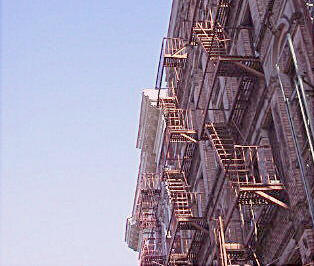
NEW YORK AT DAWN
Youth
Is no excuse for such things
Responsibilities
Weigh like strawberries
On a shortcake.
Go
To the root of the matter
Get laid....
Jack Spicer, For
Hal
A bench on Central Park West, 5 a.m., early summer of '65.
Genuine article amyl nitrite poppers and the salami-in-a-basket of a redneck named Earl, home to the nuptial couch; a hundred radios blasting salsa on the fire escapes, while he and me greased the sheets into the dawn of one of those stiflingly hot New York days that make you rage against fate for not having been blessed with crib death syndrome. But you arise from the experience with the knowledge that Priapus, not Eros, is the God of Love, and Krishna is rendered blue because he sniffed too many poppers.
And so, as the sun sinks in the west, we say farewell to West 81st Street and the friendly natives of Central Park West.
IS THIS BULLSHIT WORTH IT?
Fairfield Reading turned out to be a great place to work. While I always looked forward to returning to New York, the traveling part of the job was an unexpected plus. All I'd seen of America was eighteen years in a small town in upstate NY, four years in Syracuse and three in New York City - and a few of vacations in Florida and Canada with my parents. Now I got to meet people and live briefly in various parts of the South, Midwest and New England, and oftentimes not the major cities, which especially during the increasingly restless mid-Sixties could be very interesting. These years saw the emergence of Zen Buddhism and Existential philosophy and literature as topics of interest and controversy – and just plain fad. And while you could get a reportorial analysis of them from reading magazines and newspapers, working with college students in these years meant getting involved at the level of reading and talking with bright, lively people in an environment that was more intellectually exciting. The Hippy movement was also coming into prominence, and the view from the campus was more interesting than the one from the pages of Time magazine. (An impression I formed in these years, and it remains with me, is that while undergraduate students had a variety of views regarding the Hippies, Zen and Existentialism that it was grad students and older faculty members who embraced these things with a naive fervor.) Another plus was that as I was often on assignment alone in unfamiliar, and sometimes boring, locations which pushed me to do a lot of reading. I checked the students' books and went through the college book stores like a vacuum cleaner, so to a certain extent it was like getting to do college all over again in a Sixties mode.
[Looking back, I think it was the years at Fairfield Reading, especially the extended stays on college campuses, that caused me to have more of the attitudes and values of the Sixties in my makeup than many of my contemporaries do. I have found that the majority of the straight people in my generation stayed firmly anchored in the Fifties, and even though they were very young in the Sixties they seem to have not bothered by and large to investigate what was going on. Gay men of the same generation seem more of a mixed bag.]
When I was back at the company's offices in the suburbs there was a lot of informal socializing with the other staff members, at lunch and now and then in the city and the owner/ director of the company encouraged an informal atmosphere and gave several parties a year in his home.

There was one gay guy on the staff, Tom, a Southerner, who was pleasant and easy-going with a dry sense of humor. His sexual orientation was not something he hid, but neither did he talk about his private life at all. He and I became friends, and he introduced me to two wonderful things – the cast album of the short-lived 1956 Broadway show Candide, and the poems of the gay Greek poet, Constantine Cavafy, the genius loci of Lawrence Durrell's Alexandria Quartet. Both of these have remained favorites of mine for forty years. After a year or so Tom resigned to find work in the city.
My own modus operandi was to continue to play it straight, by editing out anything in my personal life that might suggest otherwise. There was another gay staff member, Richard – at least, I judged that he was gay. He was a heavy-set, exuberant guy, who rather aggressively played the role of company comedian, as well as mentor to newbies. I quickly became a focus of his attention, and though I liked him, I always steered away from any conversational tangents that seemed ready to swerve into an admission of our shared sexual orientation. I thought this had been a wise strategy when over the next year or so I saw him get gushingly obvious crushes on a couple of new male staff members.
In the summer of '65 I was teaching in an Upward Bound program at a black university in the South. (Upward Bound was one of President Johnson's Great Society programs to help blacks enter into mainstream American society. Upward Bound provided intensive preparation for youngsters to succeed in pre-college performance and ultimately in higher education pursuits. The goal of Upward Bound was to increase the rates at which black high school students enrolled in and graduated from college by giving them intensive instruction in reading, writing, study skills, and other subjects necessary for success in education beyond high school.)
 The campus facilities were
rather rundown and it was brutally hot and humid – with no a/c or even fans.
Richard drove down one weekend from where he was working a hundred miles or so
away, and we rented a room (with twin beds) at an air conditioned motel with a
swimming pool. It was clear after a couple of hours that Richard hoped this would
be a tryst. He became very verbally romantic at dinner, and
when it was time for bed he made his move –
but fortunately, just verbally. I
declined, and he pushed a little more, and I declined again. That, I thought,
was that. When the next day he was still pleasant, if a bit quiet, and did not bring the subject
up again as he drove me back to campus, I was relieved as I thought
that we'd now passed beyond any possible problems. I was to find out soon that
I had my head firmly inserted where the sun don't shine.
The campus facilities were
rather rundown and it was brutally hot and humid – with no a/c or even fans.
Richard drove down one weekend from where he was working a hundred miles or so
away, and we rented a room (with twin beds) at an air conditioned motel with a
swimming pool. It was clear after a couple of hours that Richard hoped this would
be a tryst. He became very verbally romantic at dinner, and
when it was time for bed he made his move –
but fortunately, just verbally. I
declined, and he pushed a little more, and I declined again. That, I thought,
was that. When the next day he was still pleasant, if a bit quiet, and did not bring the subject
up again as he drove me back to campus, I was relieved as I thought
that we'd now passed beyond any possible problems. I was to find out soon that
I had my head firmly inserted where the sun don't shine.
 I
did not return to New York until late in the summer. Shortly after I got
back, L. and D., Richard's two closest female friends in the company called me
up and invited me to Jones Beach with them and a couple of other people. At one
point L. asked me to take a walk with her along the surf. With a great deal
of discomfort, she told me that after our weekend together, Richard had driven up
to see her.
He was wildly upset and told a
confused and confusing story: I had physically
tried to put the make on him in the motel room, I had been using him for years
against another guy, and there were even hints of blackmail. When we would both
be back at work in the fall he intended to report all this to the assistant
director, our supervisor. I couldn't have been more shocked if she'd pull
out a gun. L. didn't know what to make of it, but had felt that I should
know. Later D. confirmed that he had also come to visit her with the same story.
I
did not return to New York until late in the summer. Shortly after I got
back, L. and D., Richard's two closest female friends in the company called me
up and invited me to Jones Beach with them and a couple of other people. At one
point L. asked me to take a walk with her along the surf. With a great deal
of discomfort, she told me that after our weekend together, Richard had driven up
to see her.
He was wildly upset and told a
confused and confusing story: I had physically
tried to put the make on him in the motel room, I had been using him for years
against another guy, and there were even hints of blackmail. When we would both
be back at work in the fall he intended to report all this to the assistant
director, our supervisor. I couldn't have been more shocked if she'd pull
out a gun. L. didn't know what to make of it, but had felt that I should
know. Later D. confirmed that he had also come to visit her with the same story.
I expected that what would happen is that once this big steaming turd was dropped in front of the company, we would both be told to take a hike. And there would go a job I really liked, and probably even any chance of ever getting a good reference out of it.
 When we had all returned to work, and I was expecting the bomb to
explode. Rudy, another staff member drove me back to the city in a company car
one day.
He suggested we have a drink at Dorian's or Rory's, two bars where Fairfield
people sometimes stopped off uptown on the East Side. After a couple of drinks
Rudy asked me bluntly did I know that Richard had gone around telling everyone
that I was gay and had put the make on him! Now I didn't know whether to shit
or go blind. And then Rudy began a litany of you-can-tell-me-it's-okay….over
and over again, desperately over and over again, until his hand was on mine and
his face was so close it must have looked like we were joined at the nose.
Suddenly I snapped out of my shock, and realized – ye gawds – of course,
Rudy is gay too! And Rudy is on the make.
When we had all returned to work, and I was expecting the bomb to
explode. Rudy, another staff member drove me back to the city in a company car
one day.
He suggested we have a drink at Dorian's or Rory's, two bars where Fairfield
people sometimes stopped off uptown on the East Side. After a couple of drinks
Rudy asked me bluntly did I know that Richard had gone around telling everyone
that I was gay and had put the make on him! Now I didn't know whether to shit
or go blind. And then Rudy began a litany of you-can-tell-me-it's-okay….over
and over again, desperately over and over again, until his hand was on mine and
his face was so close it must have looked like we were joined at the nose.
Suddenly I snapped out of my shock, and realized – ye gawds – of course,
Rudy is gay too! And Rudy is on the make.
I decided then and there that I was going to go to the Assistant Director, and I would be the one to make sure all this got thrashed out – enough was enough.
However, the shit did not hit the fan as I expected, and very soon Richard gave notice that he was taking a job in the city. He bid me farewell with all the sweetness of Little Mary Sunshine with a strawberry shortcake wedged up her asshole. Nothing had been said to anyone in the administration, as far as I knew – out of common sense or decency, who knows? Or just as likely it was because Richard had found his new job at one of Fairfield's clients – in effect costing the company future income – and decided it would be stupid to rock the boat too much and jeopardize a positive job recommendation.
At first, I thoroughly hated Richard for having put me through this anxiety. But rather quickly that feeling changed to one of anger with myself for not having taken pains to avoid a gay man on the work scene who had a crush on me. So, next I erred in the other direction. My desire to present an image which would pass scrutiny went into overdrive after the incident with Richard.
At Kelly-Smith one of the young secretaries had gotten very infatuated with me on the basis of me sort of "partnering" her at boozy staff lunches. When I realized what was happening I was at a loss how to squelch her interest without hurting her, and as a result I made a sloppy mess of it. Unfortunately, the same thing happened again at Fairfield – and twice! As we all traveled that meant that our contacts in the city got a bit thin, and we socialized more with each other, I think, than most employees of a company do. I chummed around a bit – at least that's how I saw it – at group get-togethers with Sarah, and was baffled when despite what I'd thought were loads of signals that it was just a pal relationship, she became romantic. Again, getting disengaged involved hurt feelings.
Sarah left, but later on Polly, a new and somewhat older female, began to actively pursue me, and to the point where she was a royal pain in the ass. Finally – Tom was still working there – we three went to lunch, and I disavowed my presumed heterosexuality to her; Tom kindly affirmed it – but she smiled sweetly, and said, "Oh, that's not true." And she continued in aggressive denial mode so that my hands used to tremble when the commuter train approached, so strong was my desire to shove her onto the tracks.
Since '59/'60 my parents had known I was gay – and shitty as the result had been, it was a done deed. And I didn't hide it from any straight people I met outside a work environment. Essentially work was the only place where I was trying to pass. This had led to three messy, unintentional "involvements" with women – though maybe my efforts at appearing to be straight had been more aggressively duplicitous and manipulative than I was admitting to myself if these had been the results. And I had put far more time and effort into straight socializing with co-workers, in the guise of a straight person, than I liked. And, of course, in the end the me that they thought they knew was a faker. In addition to which, another Richard (or some other event in future time) still might produce the very disaster I was seeking to avoid by making these efforts to pass, i.e. - in the end it could all come to nothing, and I would be identified/exposed as homosexual anyway.
I ended up really angry with myself for not at least having at least the good sense to remain aloof in work environments. I would have saved myself a lot of grief. This pretend bullshit wasn't worth it, I decided.
At the beginning of this summer I had met a guy at Riis Park, Ken. And just as this situation at work came to a head, I had moved from the apartment on 81st Street, where I was living alone, and in with him on West 72nd and Riverside Drive. This provided a perfect opportunity to start eliminating the heterosexual pretence. I worked for Fairfield for five and a half more years, most of it in two administrative positions - but from this time on, I made sure to be matter-of-fact about a personal life that focused on a male roommate and all-male socializing. It was clear to me that most of the people I supervised were savvy to what this meant – questions and references to "girl/girls" withered away and were replaced by phrases references to "you/you and your friend(s)." I never actually risked the statement, "I'm gay," but the absence of the label, as I recall it now, was only perfunctory and the staff seemed to have gotten the message.
THE LONG HOT SUMMERS BEGIN
In August 1963 there had been the March on Washington by a quarter of a million people to demonstrate support for Civil Rights legislation, and Martin Luther King, Jr. delivered his now famous "I have a dream" speech. But his leadership of the Black civil rights movement and his advocacy of non-violence were being challenged by other leaders and organizations with different views. CORE (Congress for Racial Equality) and SNCC (Student Non-violent Coordinating Committee) were prominent among them, but there were smaller, more radical groups as well. The century of injustice and poverty since Emancipation could not be redressed in just a decade of civil rights crusading, and America was now pouring enormous sums of money into the war in Vietnam - a war being fought by an army relying heavily on black soldiers. Many blacks were feeling frustration and anger, rather than hope.
The mid-Sixties saw the beginning of an eruption of rioting, looting and arson in black neighborhoods across the nation that within four years would become a terrifying specter of anarchy and insurrection. The string of "long, hot summers" had begun. In July 1964 demonstrators in Harlem gathered to protest the shooting of a black teenager by a white police officer. The demonstration was sponsored by CORE and began peacefully, but some protesters clashed with the police and general mayhem and looting broke out. The rioting lasted for two days and spread to Bedford-Stuyvesant in Brooklyn. I was out of the city traveling for six weeks and was shocked by the news on the radio. I learned from my roommate that there there had even been some minor trouble in our neighborhood at the Endicott Hotel on the corner.
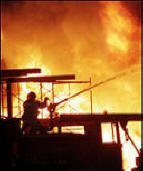 The
black neighborhood of Watts in L.A. was the scene six days of large-scale civil
unrest in August 1965. Many hundreds of buildings were destroyed by
uncontrolled fires, and during the rioting and looting thirty-four people died
and more than a thousand were injured. Damage to Watts was estimated at
$100 million. In the same year there were outbreaks of disorder in black
neighborhoods in Chicago and Springfield, MA.
The
black neighborhood of Watts in L.A. was the scene six days of large-scale civil
unrest in August 1965. Many hundreds of buildings were destroyed by
uncontrolled fires, and during the rioting and looting thirty-four people died
and more than a thousand were injured. Damage to Watts was estimated at
$100 million. In the same year there were outbreaks of disorder in black
neighborhoods in Chicago and Springfield, MA.
In June '66, after a bitter day of demonstrations and police provocation, Stokley Carmichael of the recently radicalized Student Nonviolenct Coordinating Committee (SNCC) rose and gave a fiery speech inviting violence against white rule. "We want Black Power!" he shouted, and the crowd shouted the slogan back. This speech and the events of the recent summers signaled a cleaving in the black civil rights movement away from the non-violent rhetoric and strategy of Dr. Martin Luther King, Jr.
In the following year riots broke out in the black Hough neighborhood of east Cleveland in July. The violence lasted for several days and the police were unable to regain control, and in the end more than 2,000 National Guard troops were called into reestablish order. Again, arson and looting destroyed blocks of homes and businesses. That same summer of '66 more riots broke out in Dayton, Milwaukee and San Francisco.
THE SIP-IN: THE BEGINNING OF GAY LIBERATION IN NEW YORK
"In the
world's most exciting city dreams become rights with a bang."
William Trevor
I
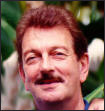 n April 1966 Mattachine sent out press releases and
telegrams announcing that it was going to challenge the SLA regulation that
prohibited bars and restaurants from selling alcoholic beverages to homosexuals
under penalty of having their licenses revoked.
n April 1966 Mattachine sent out press releases and
telegrams announcing that it was going to challenge the SLA regulation that
prohibited bars and restaurants from selling alcoholic beverages to homosexuals
under penalty of having their licenses revoked.
(right) Dick Leitsch, Mattachine Society
The participants would enter a licensed premises, make a statement of their homosexual orientation and order drinks. When service was refused Mattachine would initiate a test case in the courts. On April 21 reporters from the Village Voice, the New York Times and the New York Post showed up to accompany Dick Leitsch, John Timmons and Craig Rodwell in what was expected to be virtually an instant test case incident.
The first stop – and the only expected one – was the Ukrainian-American Village Bar on St. Mark's Place. This bar had a posted notice: "If you are gay, please stay away." A politer warning, but reminiscent of the old racist jingle: "If you're black stay back, if you're brown keep down, if you're white - you're alright." Unexpectedly it was not open for business that day. The assumption was that the management had been forewarned by the publicity and knew that their posted policy made them a most enticing target.
The Mattachine group and the reporters then went to Howard Johnson's at Sixth Ave. and 8th St., which had a policy of not serving gays. When the Mattachine group made their statement and requested service, the manager genially refused to become engaged in the set up. He bought drinks for everyone and sat down to have a chat with the group.
They then departed for the Waikiki Bar on Sixth Ave. between 9th and 10th streets. (This had been a gay bar under another name not too long before.) The bartender refused to become involved and allowed that he would serve them. By now everyone was getting a glow, but the Mattachine trio was discombobulated that homosexuals - with an entourage of reporters, at least – were magically proving to be acceptable customers that day.
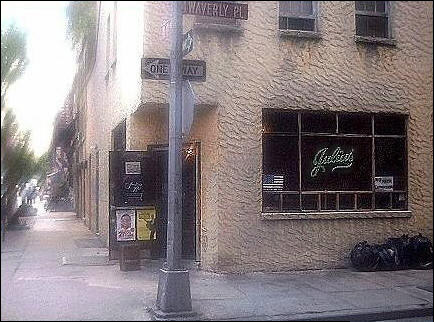 Next stop for the entourage was the Julius' Bar on
West 10th St., a village landmark known to New Yorkers and tourists. The bar
had an unhappy relationship with gay customers, and since the Wagner purge of
gay bars it had found itself trying to fight off a much larger than usual gay
clientele. Gay entrapments had occurred there recently. One of the three Mattachine members,
Craig Rodwell, had been ejected for wearing button that said "Equality for
Homosexuals.
Next stop for the entourage was the Julius' Bar on
West 10th St., a village landmark known to New Yorkers and tourists. The bar
had an unhappy relationship with gay customers, and since the Wagner purge of
gay bars it had found itself trying to fight off a much larger than usual gay
clientele. Gay entrapments had occurred there recently. One of the three Mattachine members,
Craig Rodwell, had been ejected for wearing button that said "Equality for
Homosexuals.
Julius's, site of the "Sip In"
Over the years I dropped in there on an on-again-off-again basis. It was the only "gay" bar in the Village that remained open throughout the Wagner years, though this had to be because it maintained determined hostility to gay patrons and had a lot of straight customers. The management stuck to an aggressive anti-gay policy, and in the face of losing their license for what was a famous landmark bar and a commercial gold mine that's hardly surprising. You usually had to be guarded about your conduct and service often ran a narrow gamut from aloof to hostile; there were times when the bartenders actively forbid men to move from table to table or to stand with their backs to the bar. Nevertheless, when the bar was not packed with customers (and perhaps when the owners or managers were not around) the atmosphere sometimes improved, and a couple of the bartenders were cordial to Village gay men who were regular customers.
When the Mattachine entourage arrived they recognized other gay customers at the bar. "We're homosexuals and we would like a drink," Dick Leitsch said to the bartender. After a curt exchange, the bartender said the magic words the law required of him: "I can't serve you." Leitsch immediately announced that Mattachine would file a complaint with the SLA against the Julius' Bar for discriminating against gay people in violation of the First and Fourteenth amendments of the U.S. constitution. But also, he said it would pay the bar's court costs.
It must have been the next day that I read a small article in the back pages of
the Times about the "deviates" and their sip-in. While I was used to black civil rights
protesters using these tactics to challenge segregation, I was bowled over that
these gay guys had taken it upon themselves to do the same. I was also
very happy that
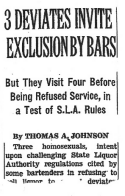 Julius's had been their successful target.
Julius's had been their successful target.
(right) NY Times April 26, 1966, story of "deviates" sip-in on inside page.
The State Liquor Authority quickly moved away from a constitutionality test by declaring that it would take no action against bars that served homosexuals. Thus, it would seem that de facto the SLA stranglehold had finally been broken – however, there would have been no test of constitutionality, and the regulation would have remained legally unchallenged. The denial of public accommodation to gay people in New York State would still have been enshrined in their regulations.....and still there to be re-invoked at some future time perhaps.
At this point a deus ex machina appeared in the form of William H. Booth, the black chairmen of the Commission on Human rights. He responded to the SLA announcement by saying that the Human Rights Commission had jurisdiction over discrimination complaints based on sex, and if a complaint were made by Mattachine to the Commission he would seek to put an end to the SLA regulation. Mattachine filed that complaint pronto! If there had been doubt before about whether the SLA would quietly keep its anti-gay rule in reserve, it was now clear that option was headed for a quick death.
Newspapers and prominent citizens spoke out against the SLA's regulation, and after some confusing maneuvering as to who would press the case, the following year the Appellate Division found in favor of the Mattachine position. This was the redress of the verdict – a quarter of a century later – in the courageous lawsuit brought by the owners of Gloria's bar back in 1940. And there ought to be a plaque on the wall of Julius's commemorating these events!
(It is important to remember that these developments did not affect premises which served alcohol without having a New York State license. All such places, regardless of who their clientele was, were illegal as they had been and still are, though there was some fuzziness about so-called private membership bottle clubs. Thus, the unlicensed Stonewall Inn was still an illegal establishment. Running an unlicensed premises is a crime, and does not come under the purview of the SLA, but of local law enforcement officers.)
While Julius's is often described as New York's oldest gay bar, that's a total load of bullshit. Not until after the Mattachine sip-in and the subsequent publicity and legal actions did the bar welcome gay patrons. Prior to those events it was a bar that gay men patronized, but it was most emphatically not a gay bar. After all, if Julius's had been a real gay bar -- why would the Sip-in have taken place there? The honor of being the oldest continuously operating gay bar in New York without a doubt belongs to the (recently closed) Candle Bar on Amsterdam Avenue & West 74th Street. It had operated as a bar for gay patrons since the mid-Sixties, and had employed a gay and lesbian staff during those years as well.
For a very brief time some police continued to play games with licensed gay bars and their patrons. Once in a while a couple of uniformed men might visit a bar, hulking their way from front to back and out again, all the time looking balefully at the customers. I can also remember a well lit police car parking directly in front of the Candlelight Lounge for twenty minutes to a half hour while the cops watched the bar as if preparing to enter.
The new Police Commissioner, Sandford Garelick, had told Dick Leitsch in a public forum that police entrapment of gay men had been ended. However, shortly after the Sip-in an Episcopal minister eating in Julius's witnessed the entrapment of a gay man. He was shocked and called another minister (and eventually – it has been said – even the Episcopal bishop had been notified.) When Lindsay was involved he called a meeting the next day in a Village cafe. It was a pretty Sixties group that showed up: Mayor Lindsay, Commissioner Garelick - and his wife, some reps from the ACLU, gay poet Allen Ginsburg and the Fugs, a popular group of folk/protest musicians. By the end of the meeting police entrapment of gay men was defunct - according to the new policy only a private male citizen could bring charges for being propositioned by another man.
[Dick Leitsch died 22 June 2018, age 83, of cancer in a hospice in New York City. He was the subject of a major obituary in The Washington Post.]
When Mattachine complained to the city's Human Rights Commission about anti-gay discrimination in city hiring policies, the City applications were changed and questions about sexual orientation were not admissible. However, there was a glitch here as both the fire and police departments refused to comply, just as they staunchly resisted Lindsay's attempt to get them to hire more blacks and Hispanics into their overwhelmingly white ranks. Both of these departments were deeply conservative, at least at the level of their longtime members and supervisors. They loathed Lindsay and resented and obstructed his liberalizing policies. In an era of rapid and dramatic social change they were very unhappy (and worried about the negative impact that poorer non-white minority members would have on future union contract negotiations), and Mayor Lindsay soon became emblematic of everything they saw as going wrong in the world as they would have it.
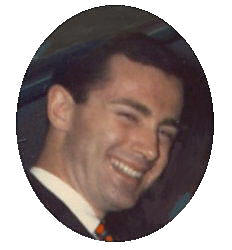
Me, mid-Sixties
Once again the New York gay world was turning upside-down – only this time upside-down was right-side up. More bars had been cautiously opening up in the waning days of the Wagner years, and now more and more gay businesses opened – some of them unlicensed dance bars. Outside the West Village, on the Upper Westside and the East Side, local gay bars began to attract and hold a steady clientele who no longer headed downtown every time they wanted to go out. On a night out it was possible to dine in a gay restaurant, see a gay play in a gay theatre space and then stop in at a gay bar. In no way was the entire official menu of civil rights available to gay people – but Lindsay made a start. Major changes were occurring in the tenor of life of the city, and greater gay visibility was becoming part of the scene. The change of administrations from Wagner to Lindsay can reasonably be taken as the point when the Sixties, as they are popularly recalled at least, finally replaced the Fifties in the city. Mayor Lindsay dubbed New York "Fun City." And the physical city itself rapidly lost those vestiges of film noir look and atmosphere which had hung on even after the end of the Fifties. Not since Jimmy Walker had the city had a glamorous mayor who loved the pulse of its life and the dazzle of its entertainment so much. And New Yorkers were loving it with him - not the least gay New Yorkers. Freedom and exuberance were in the air.
mail to: nycnotkansas@gmail.com
![]()
CONTENT-RELATED LINKS - checked 28 January 2020
(each section of the site has its own links)
Under the Mink - slide show of male and female drag in the Village, 40's and 50's
Weegee - famous photographer of NYC
Take the A Train - NY Times article on 75th anniversary of the A Train subway line
Dick Leitsch/Mattachine NY - a well-deserved tribute by Jack Nichols a 60's gay activist
The Raided Premises - NYCPD site with story of raided gay bars in the 60's
Times Square/Samuel Delaney - review of Delany's book on Times Square
Jack Robinson Archives - excellent site with many example's of Jack's work by the people who have preserved Jack's work
Jack Robinson bio - Biography of Jack Robinson
Belvedere Guest House, - Cherry Grove, Fire Island - great photos, reservation information
As the Grove Turns - a news site about present-day Cherry Grove created by longtime resident Richard LaFrance. This site has not been updated in awhile: however, the past sections are worth looking through as they usually contained a history/nostalgia article.
Tom of Finland - master of gay erotica and macho porn
Old Reliable - photographer of rough trade (scroll down about halfway)
Jack Spicer, gay poet
Like the Sun Rushing - novel set in the NYC gay life of the 60's - 80's
Cherry Grove, by Esther Newton - a history/sociological study of the Grove that rang true to me.
GENERAL INTEREST LINKS - checked 29 January 2020
Eighth Street Book Store - famous Village landmark of the era
Rafi Zabor - interview with author of Pen-Faulkner prizewinner of The Bear Comes Home. The book is great.
Night and the City - album Kenny Barron and Charlie Hayden, cover text by Rafi Zabor. Two jazz artists who are at their peak, great performance!
Forgotten New York - one of the top sites on anyone's list of NYC web sites, surviving artifacts of bygone years, terrific site with many original photos
ExploreNYC - again, a top web site for anyone interested in NYC
Dawn Hampton - great summary of Dawn's career
New York in the Sixties - Klaus Lehnartz (photos), Dover Publications
Recordings available from Amazon.com and other sources
Afro Cuban Jazz Project, Campinas
If the Moon Turns Green, Billie Holiday
Netania Davrath, Songs of the Auvergne - the absolute classic recording of these songs.